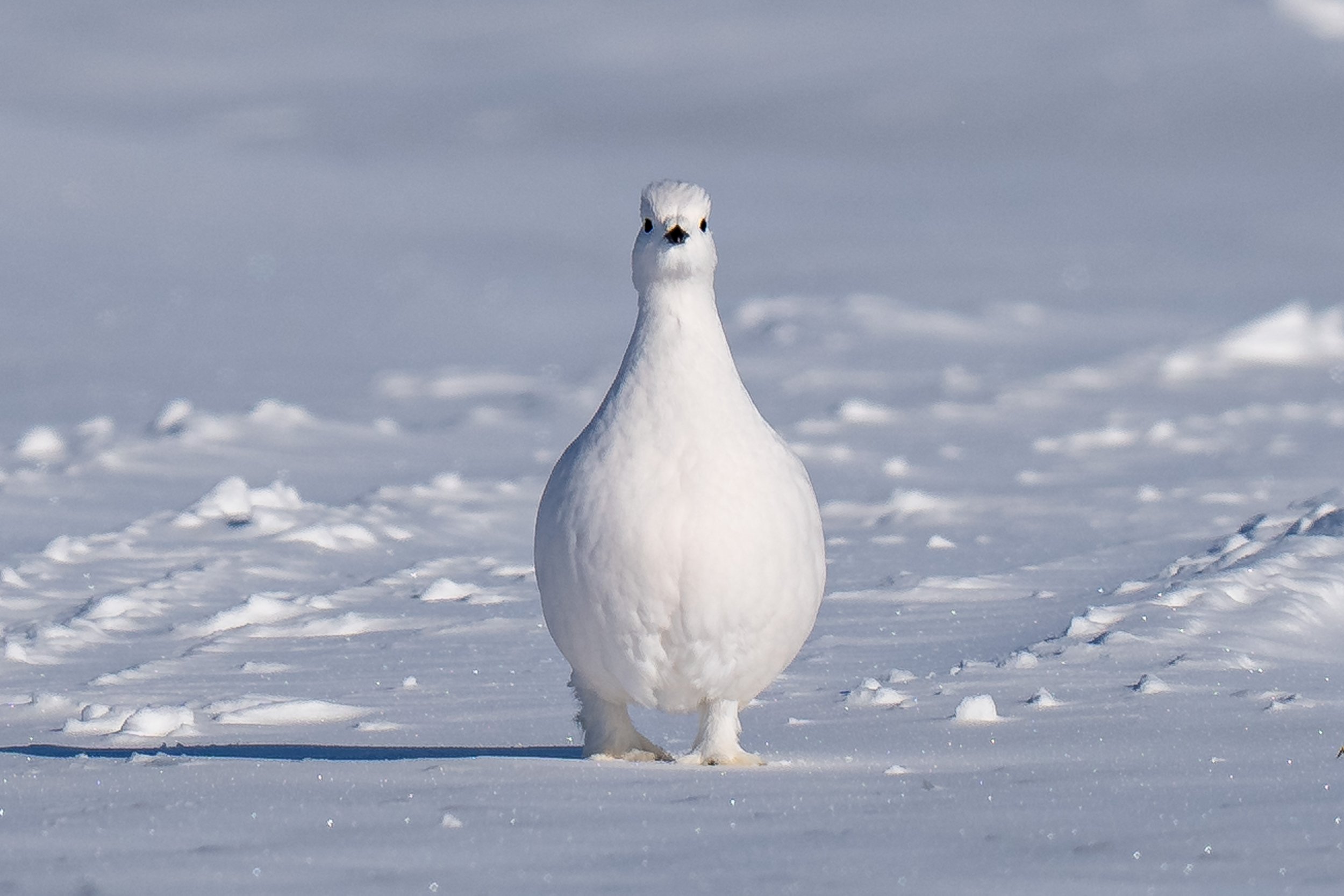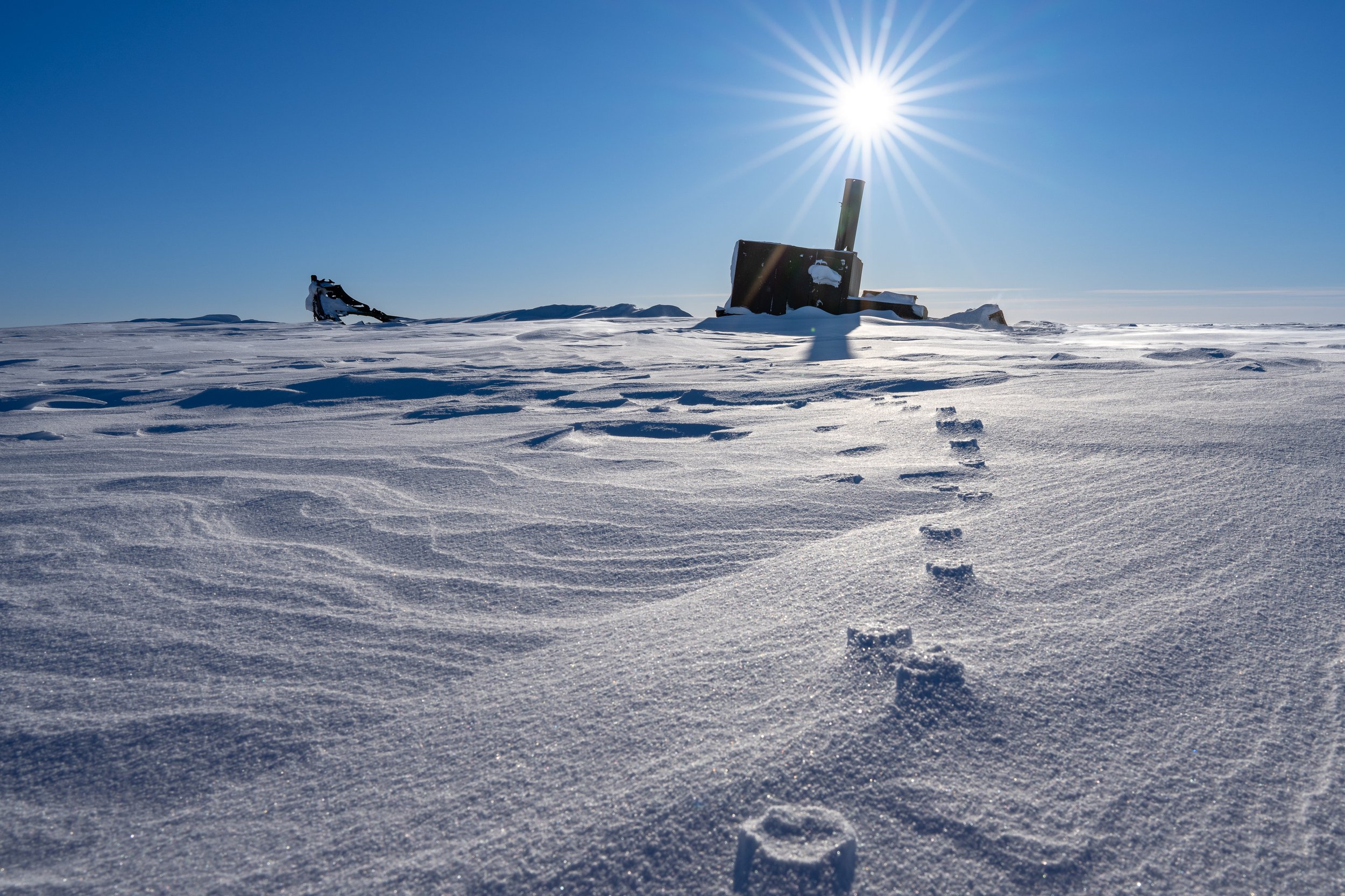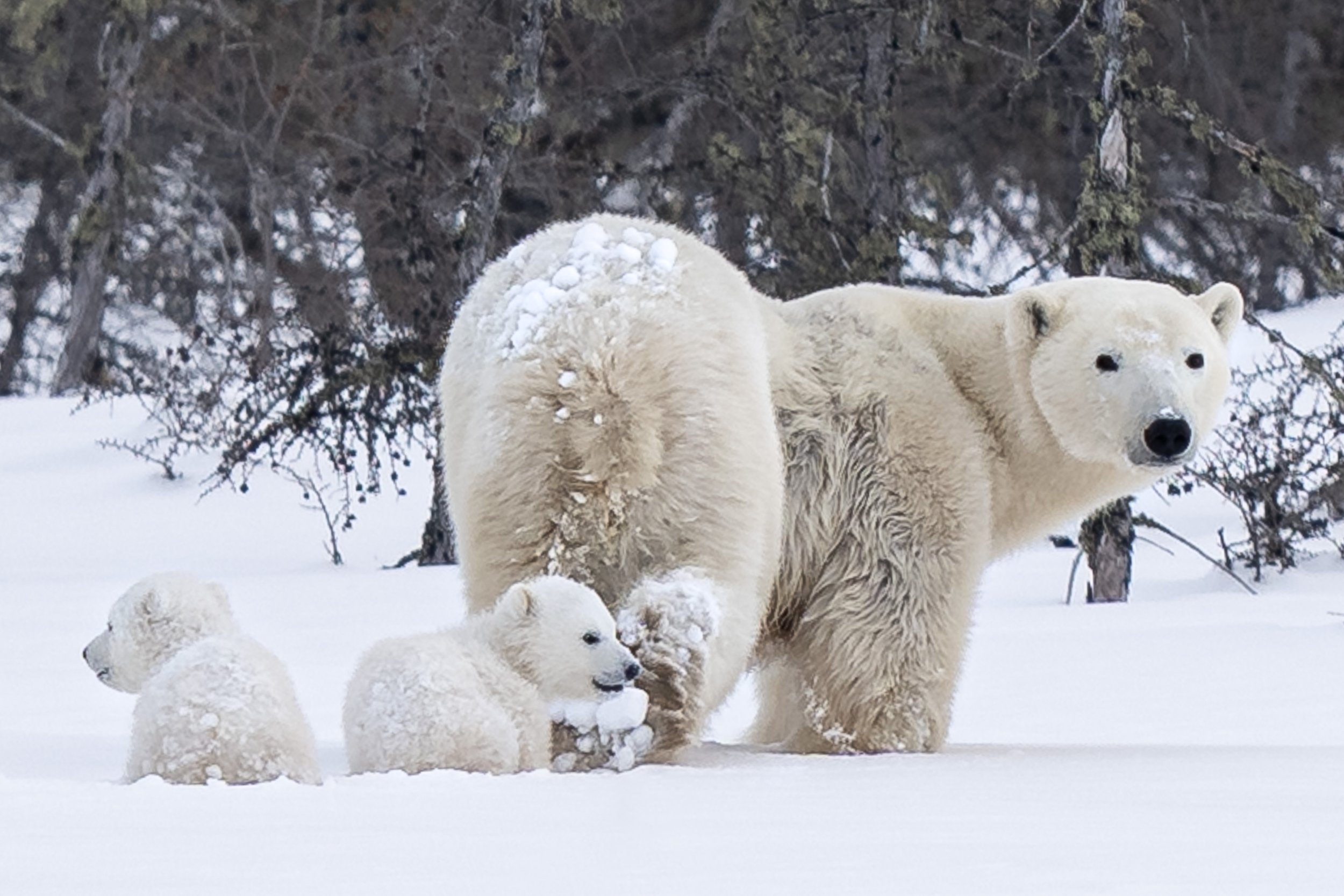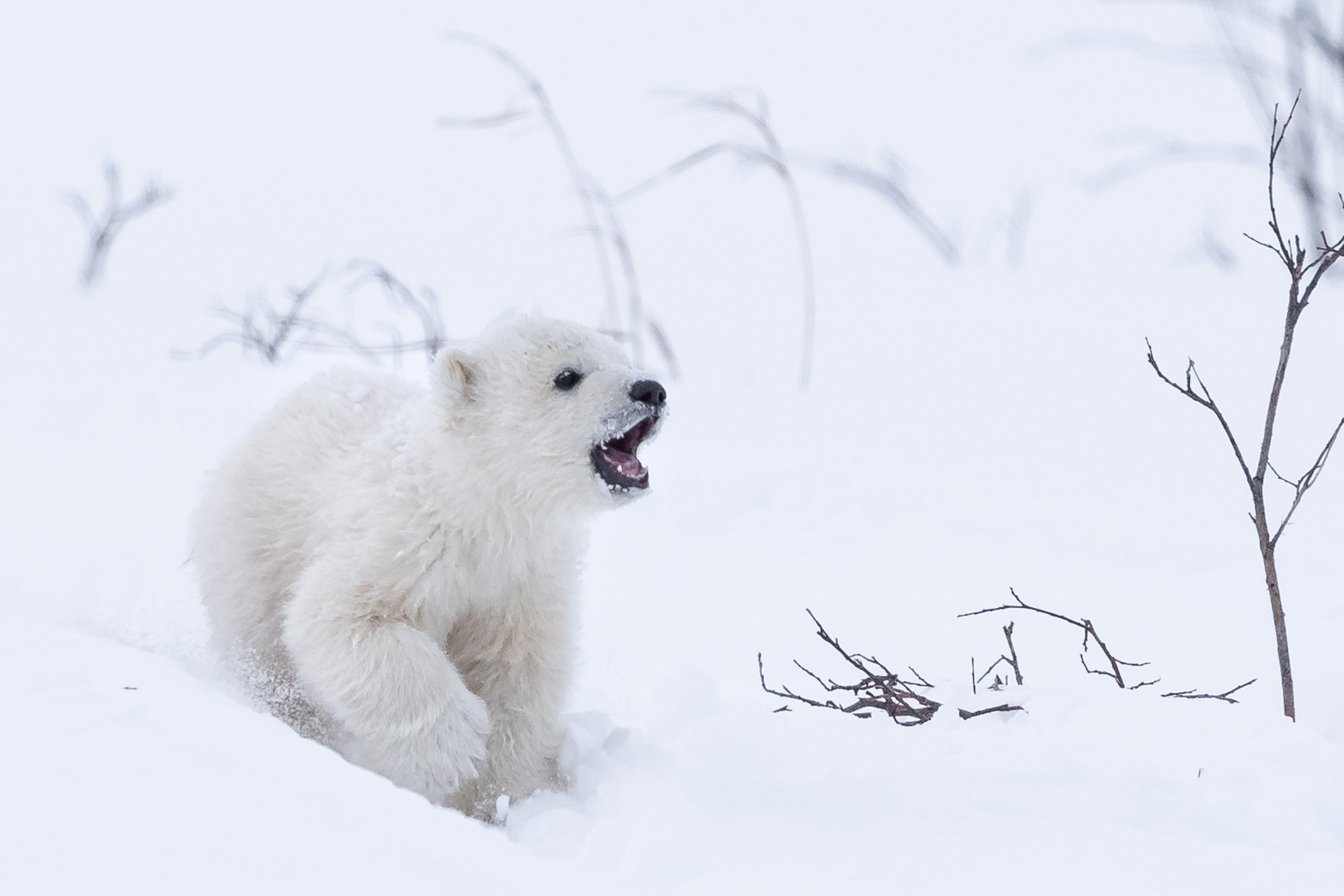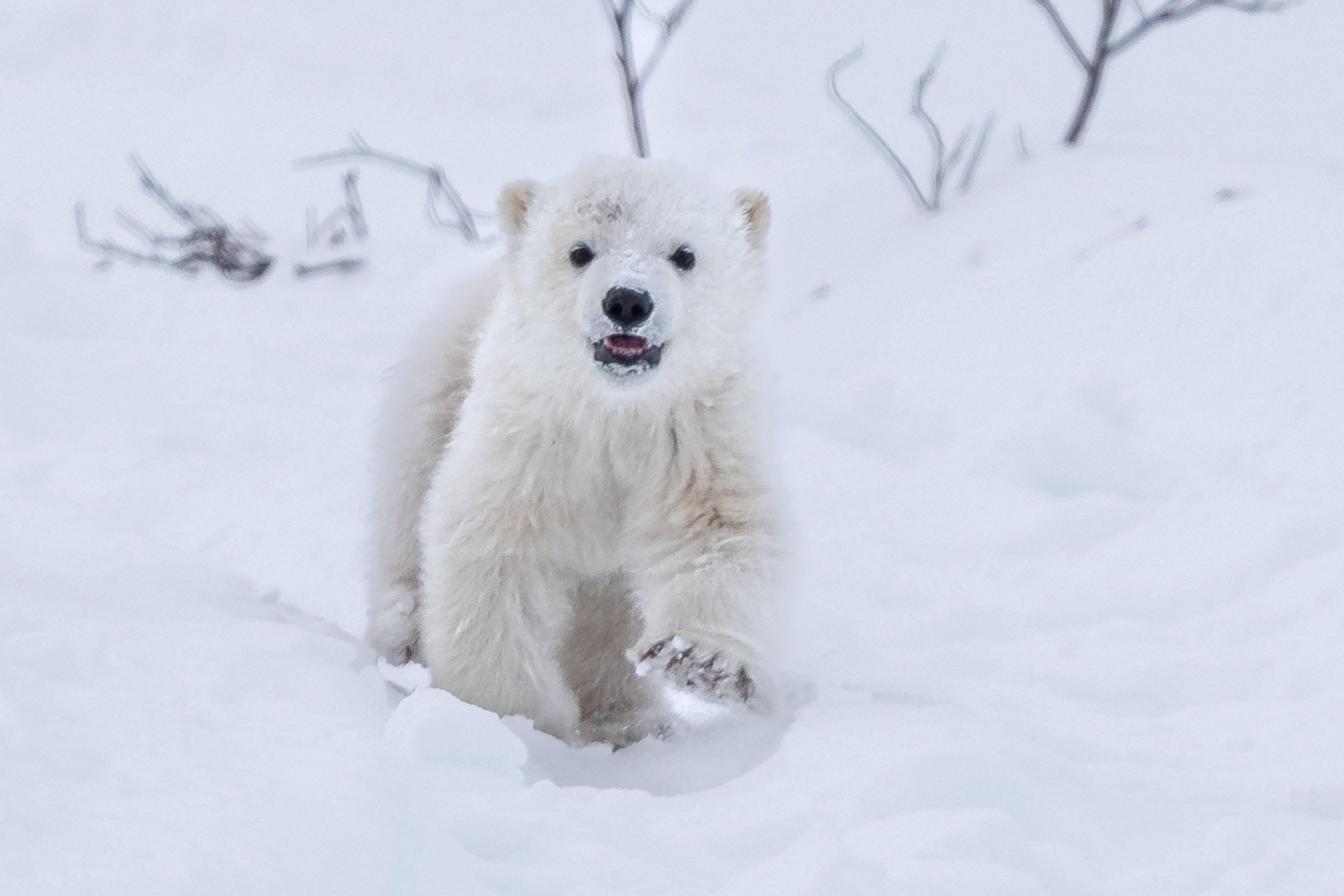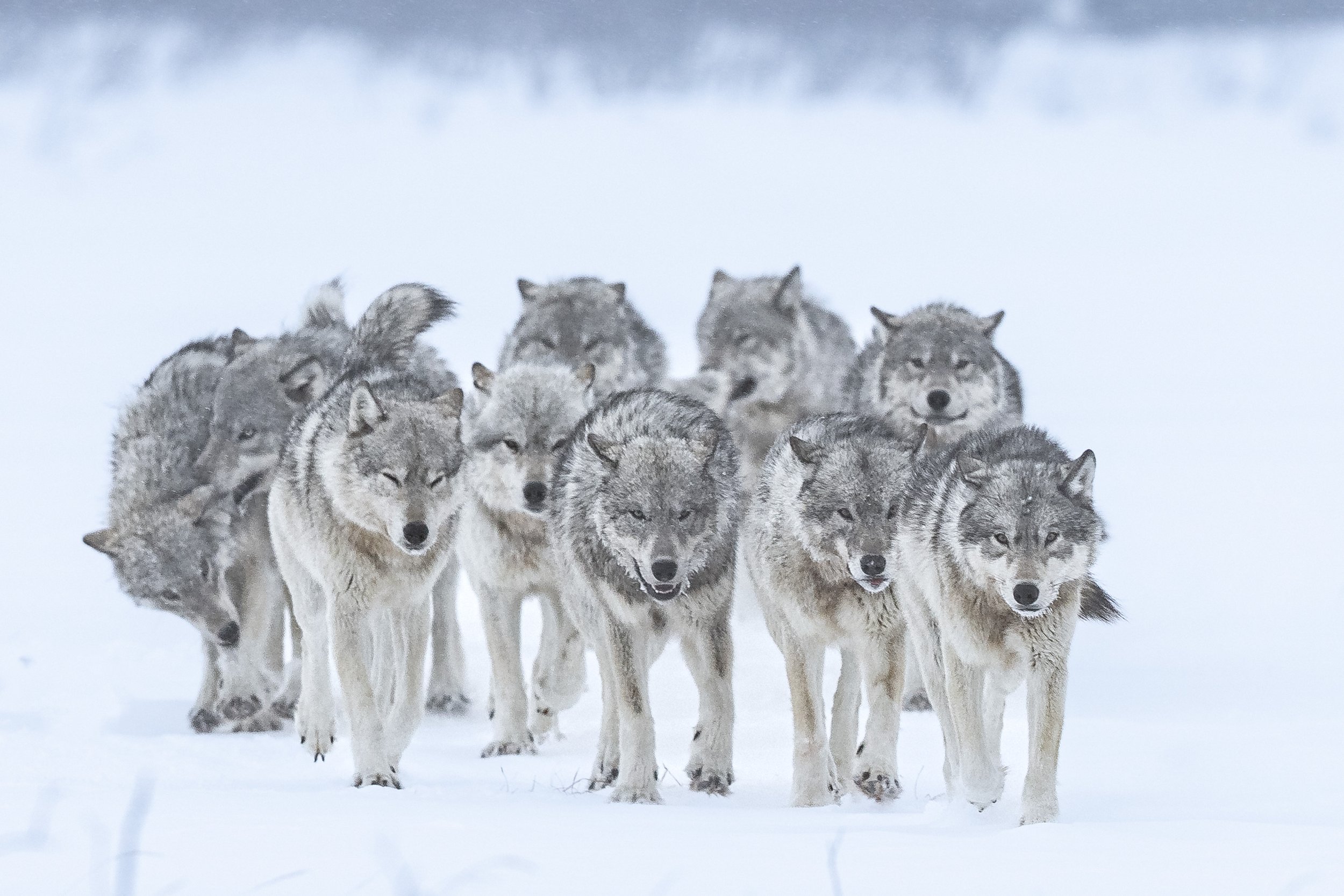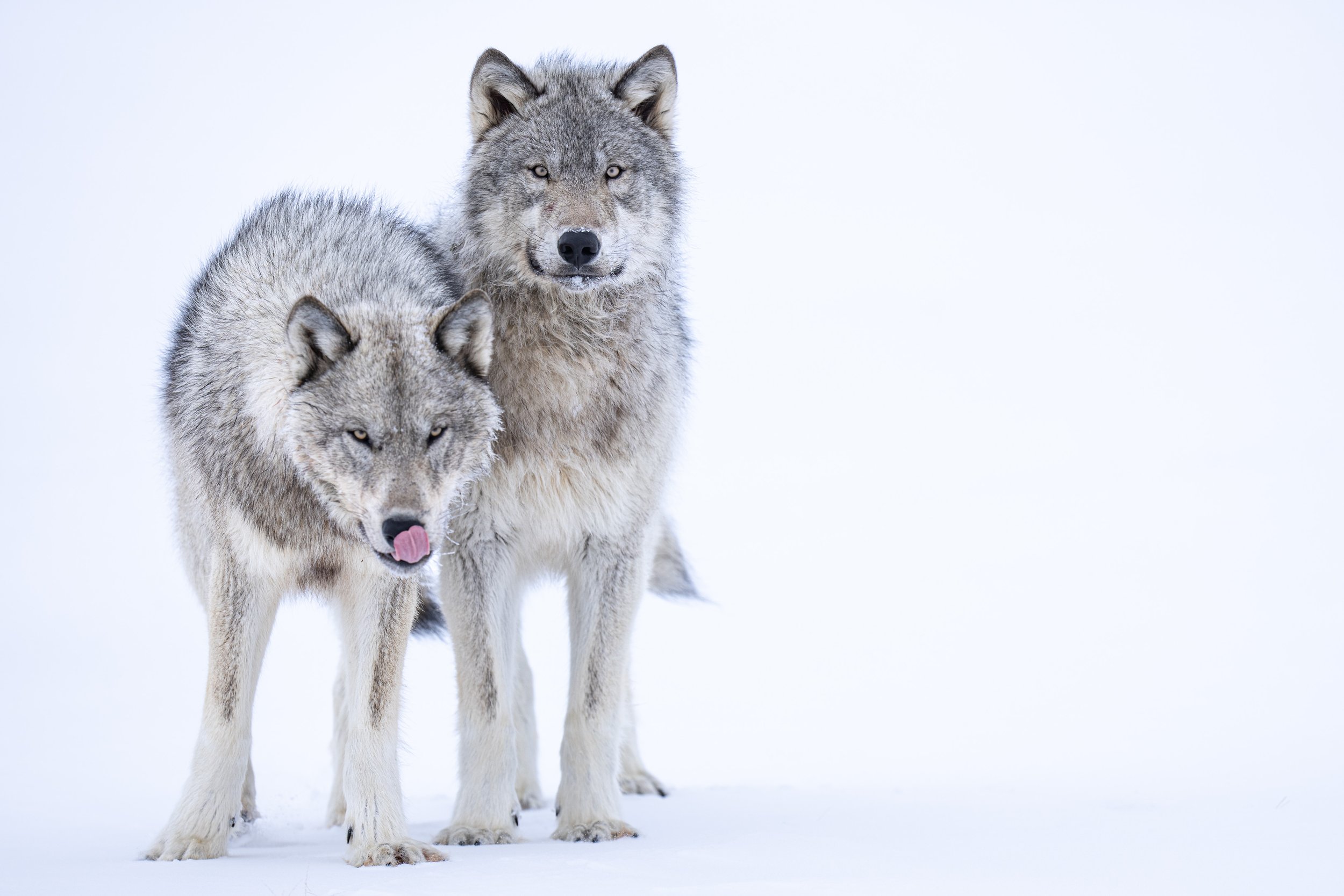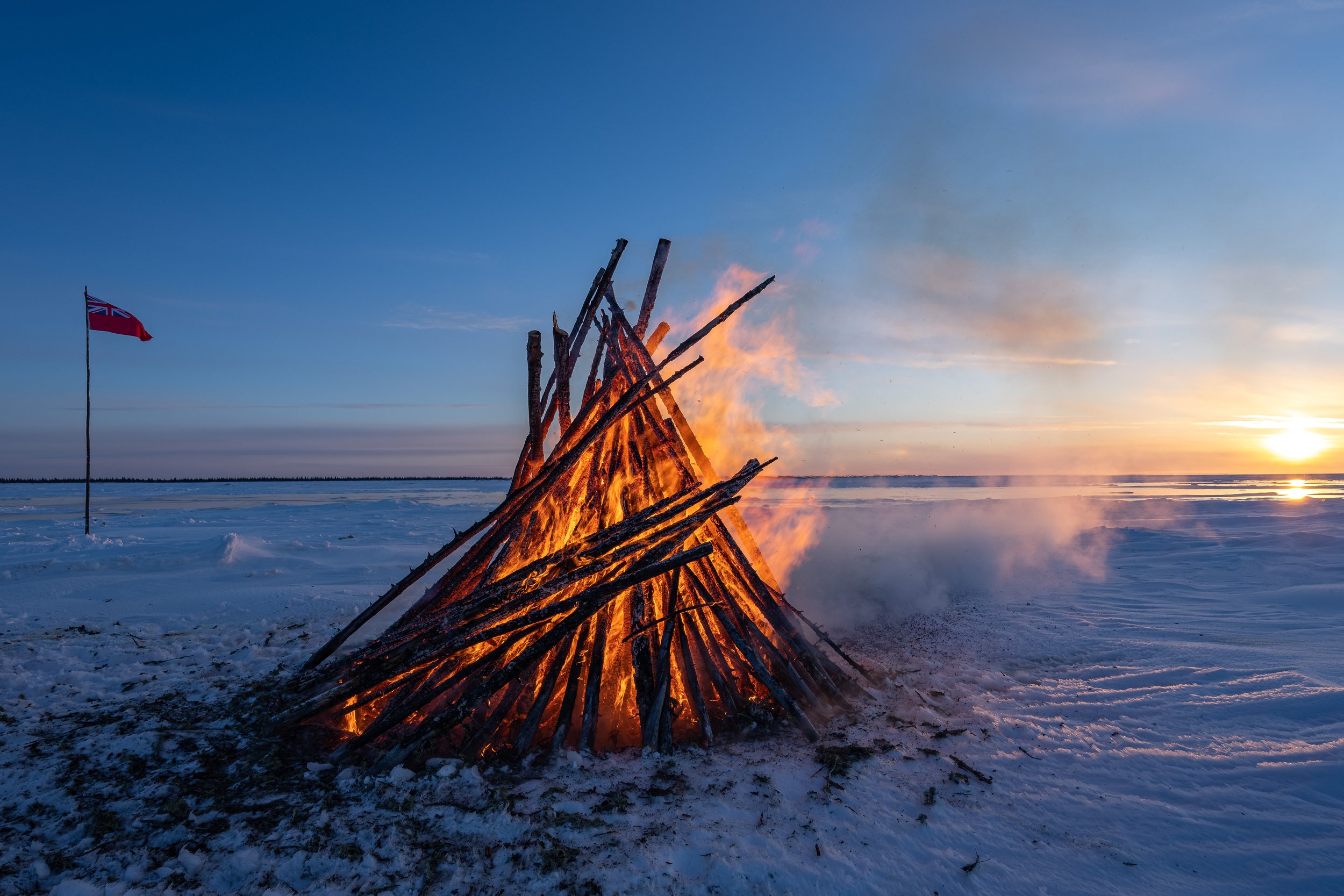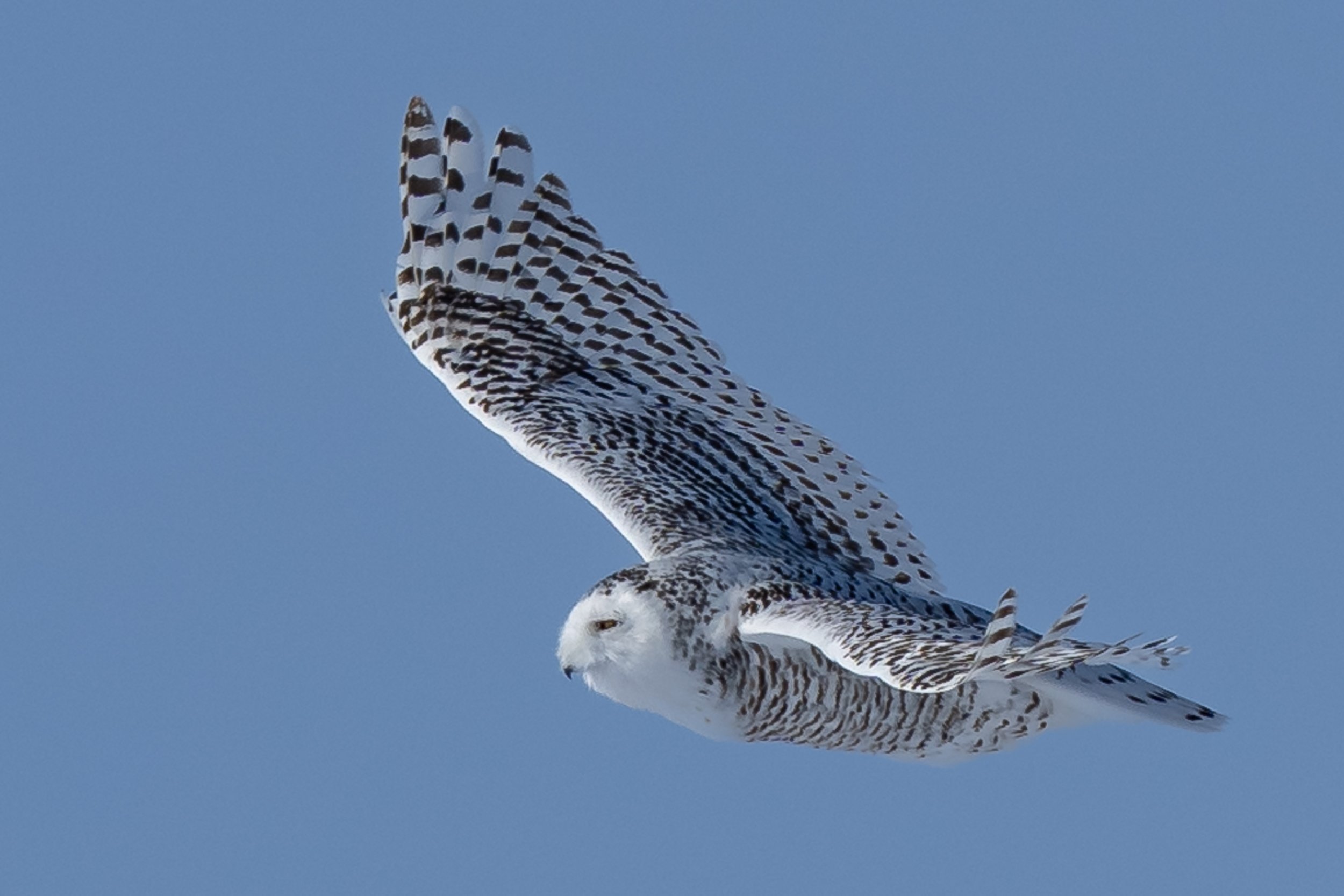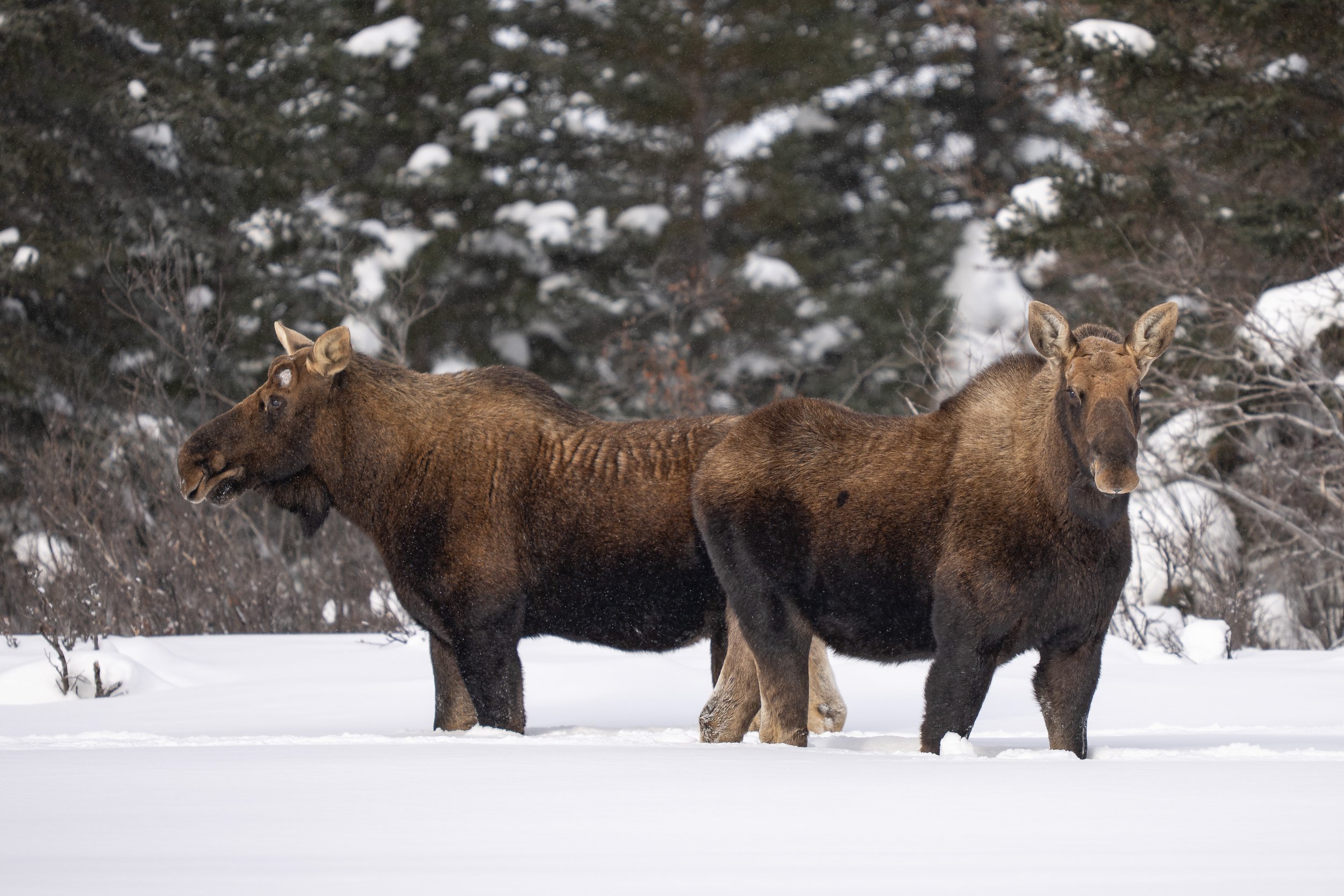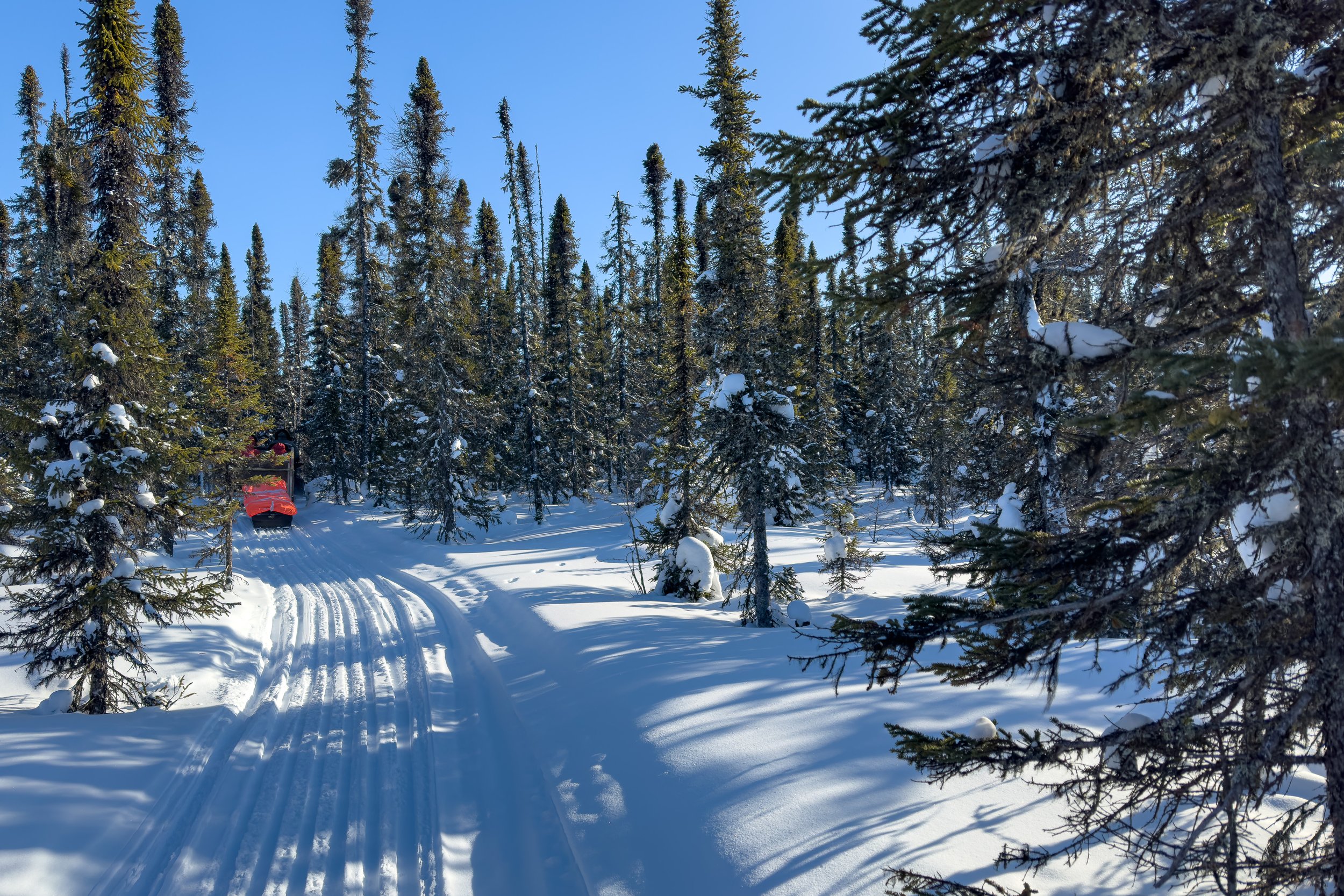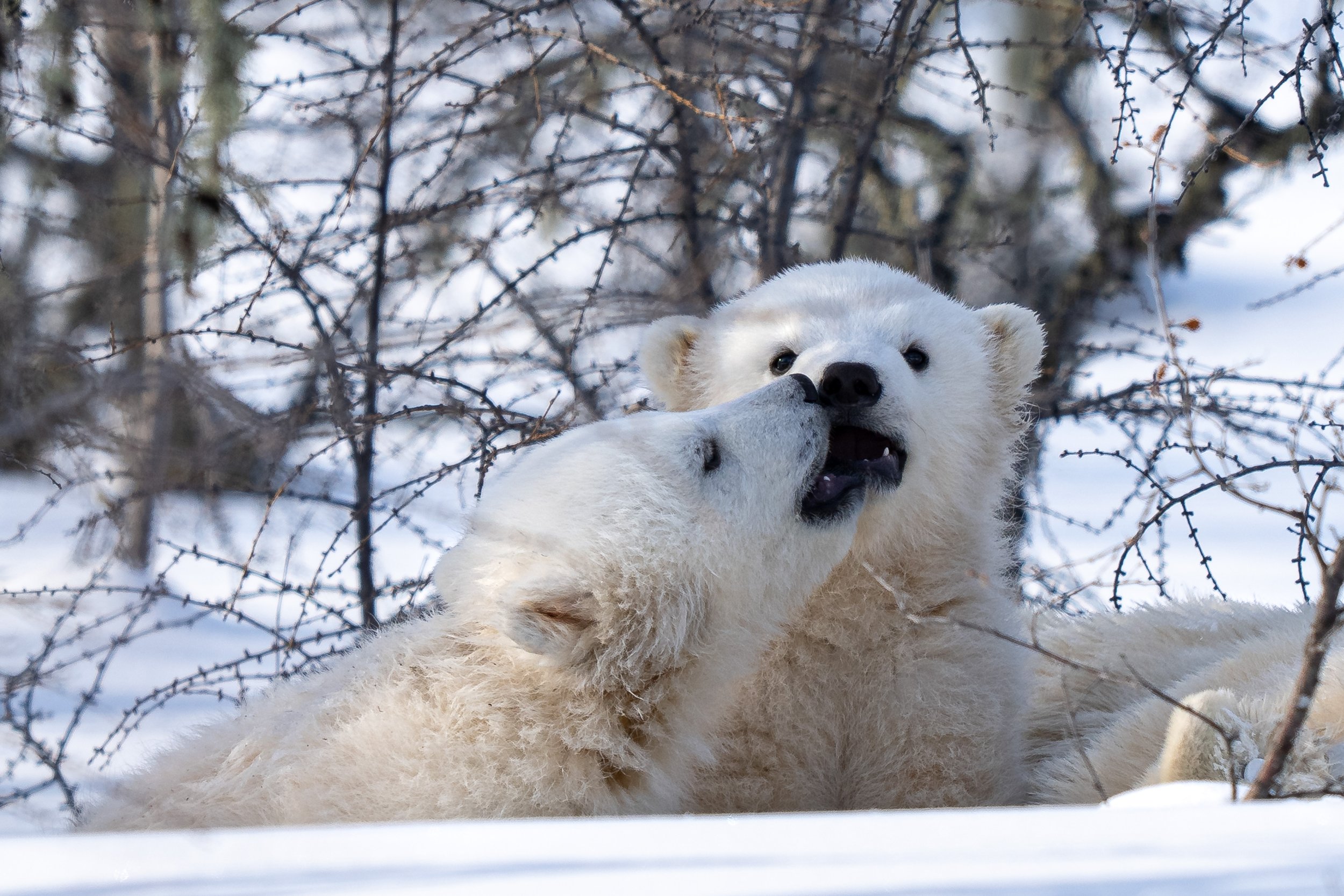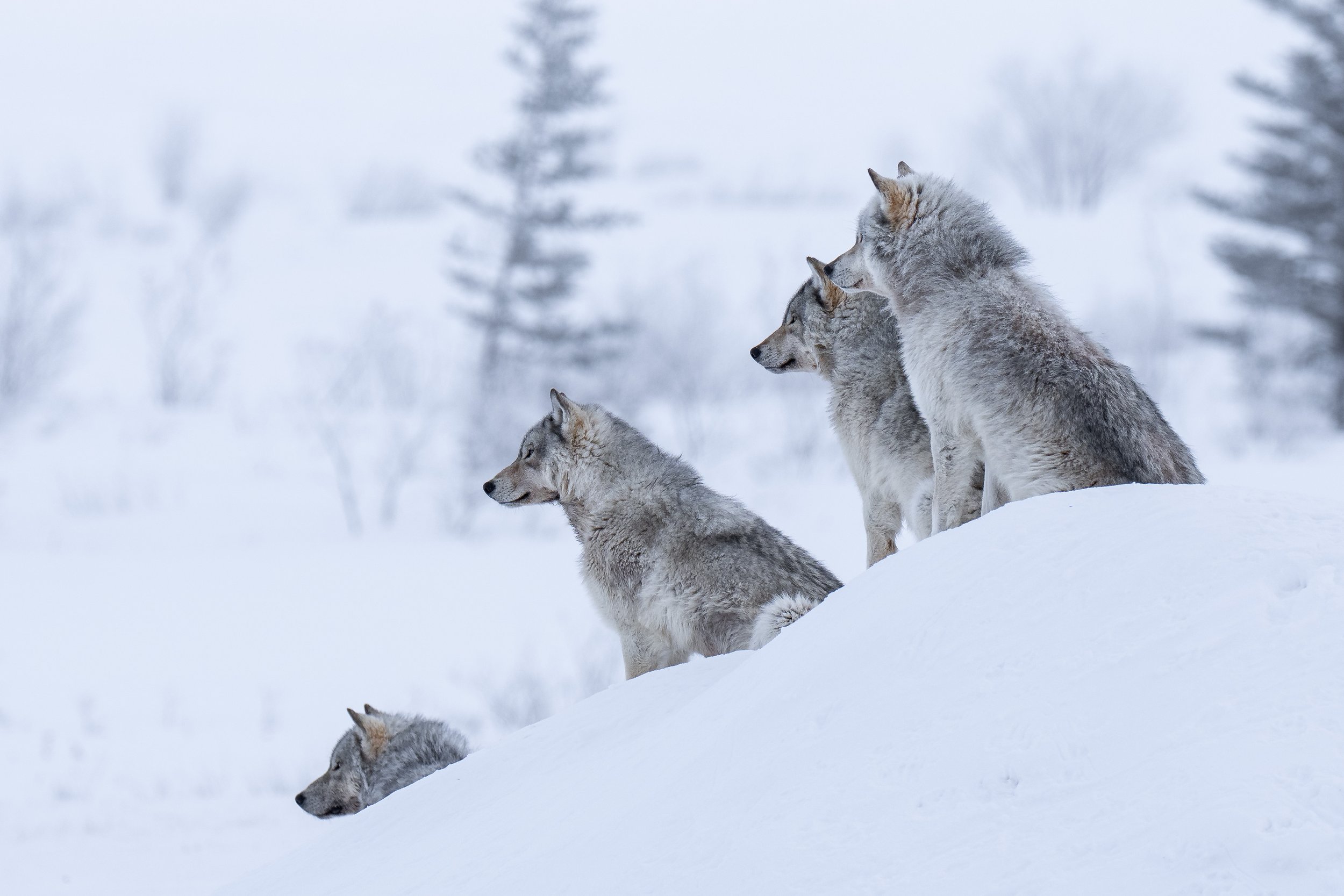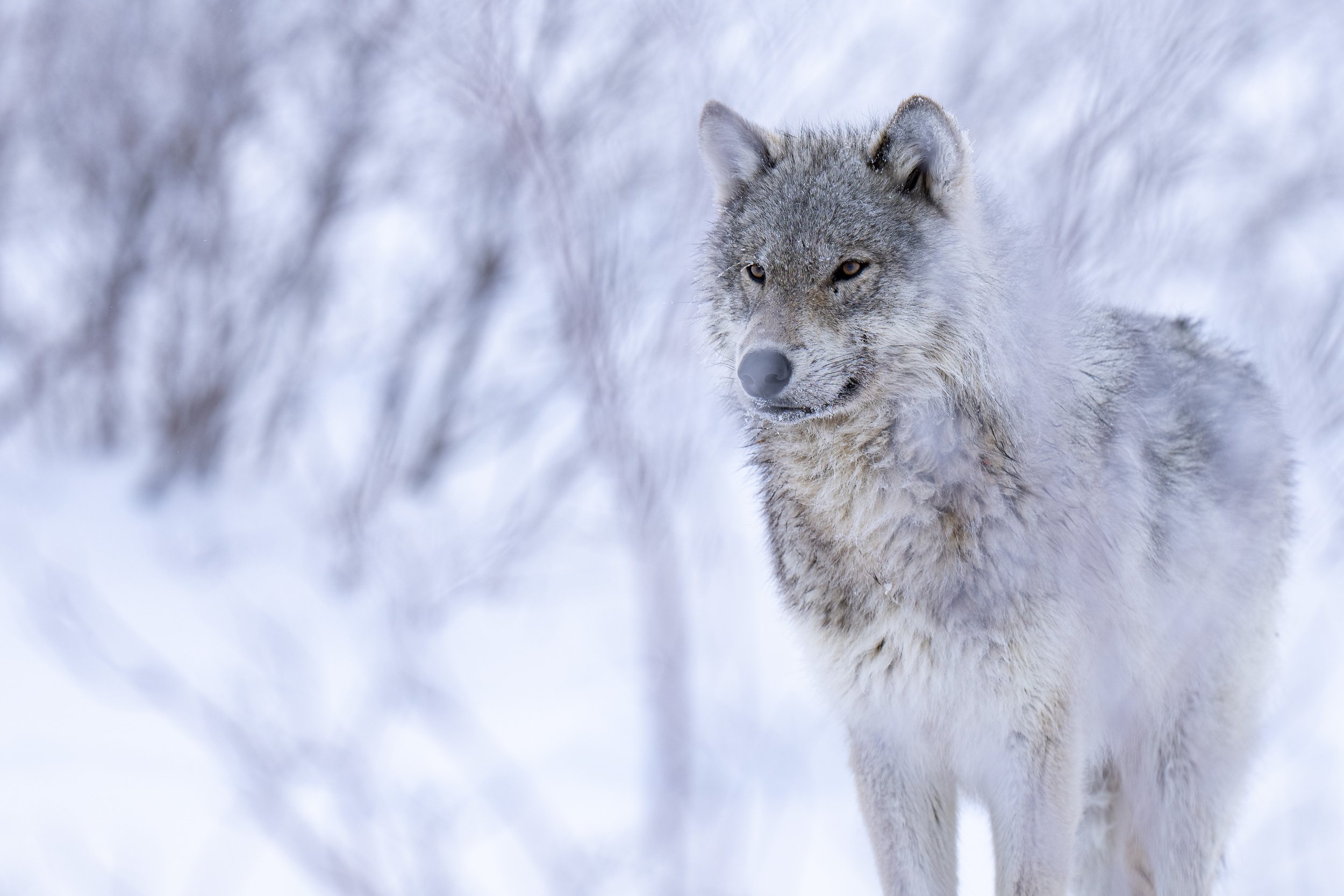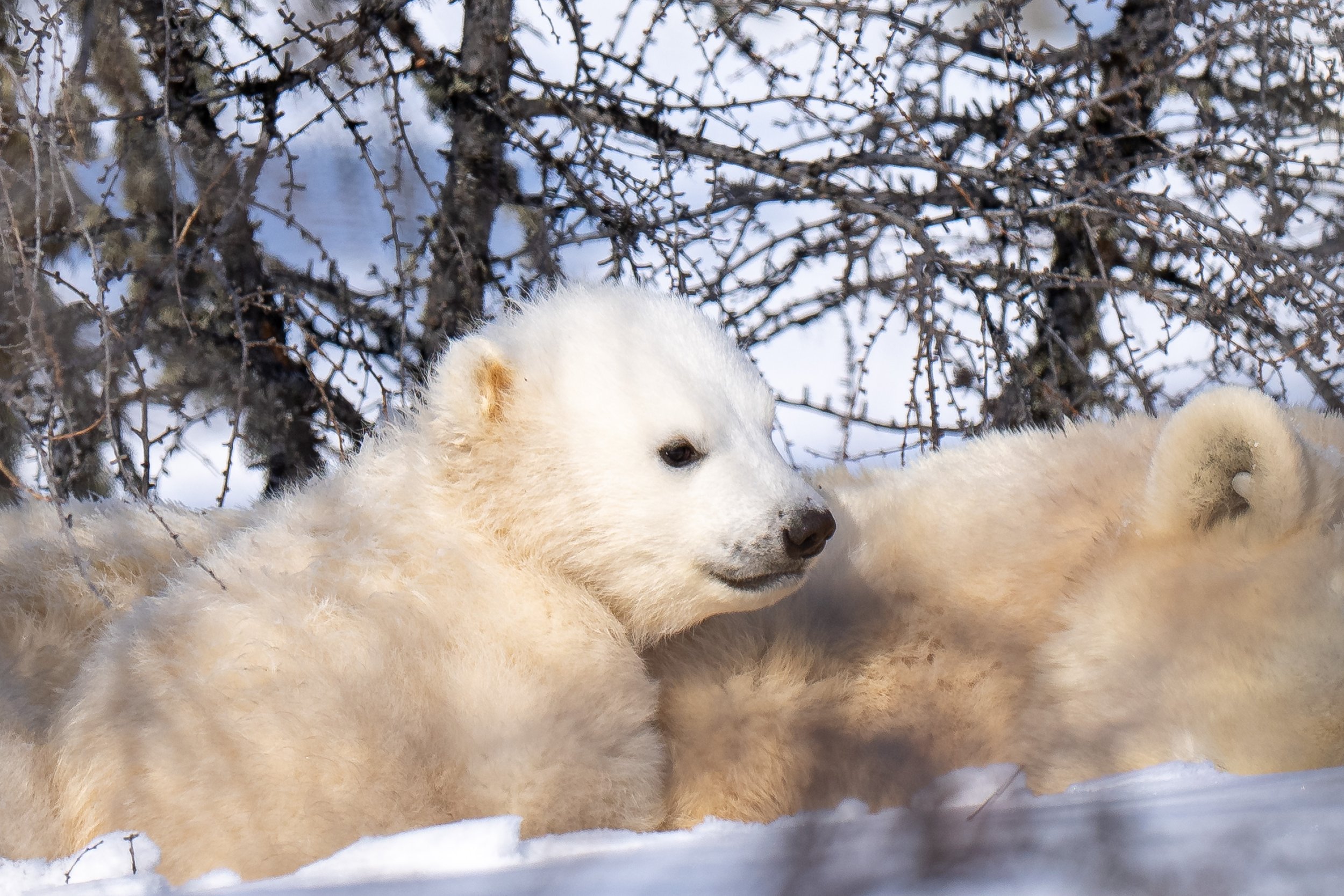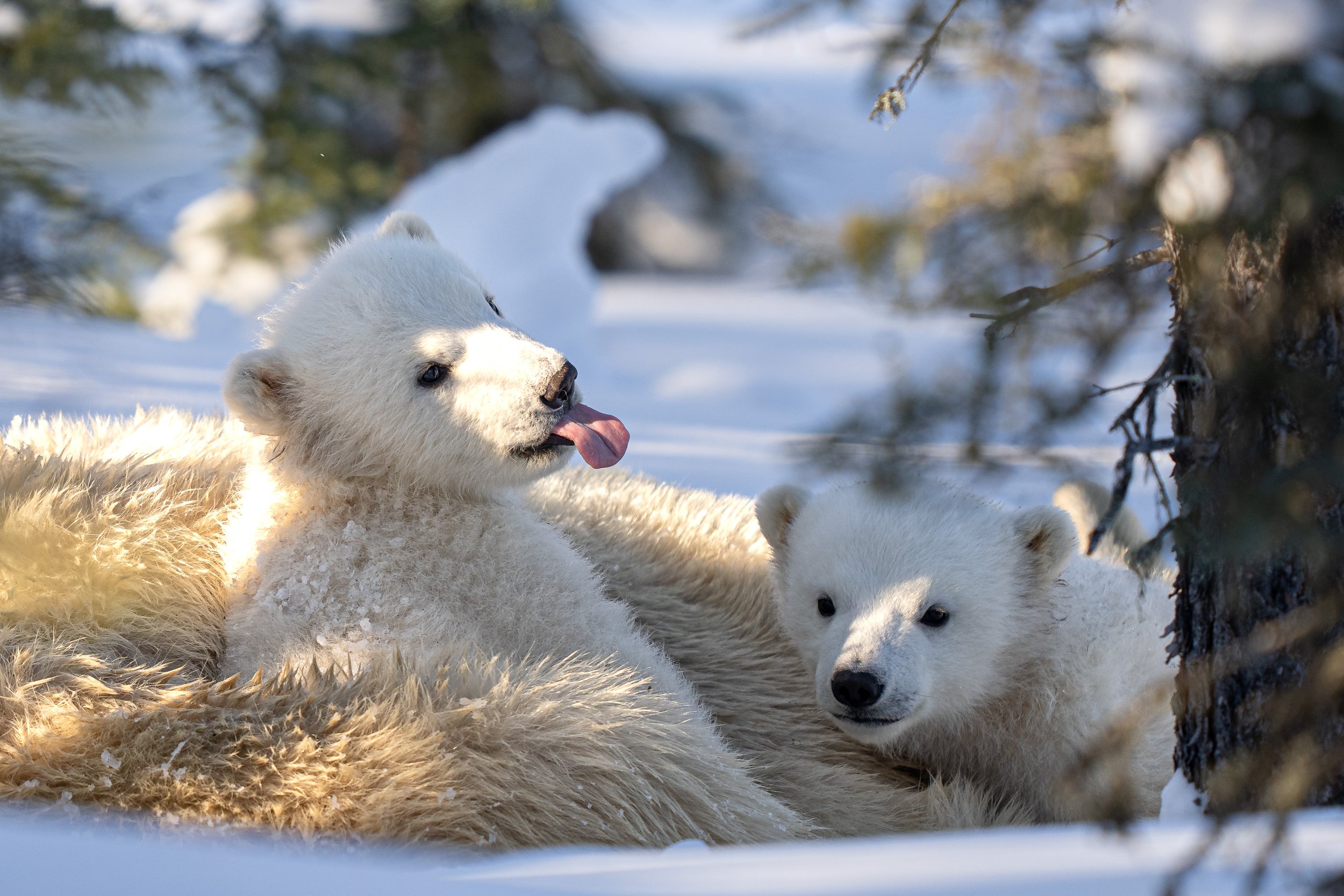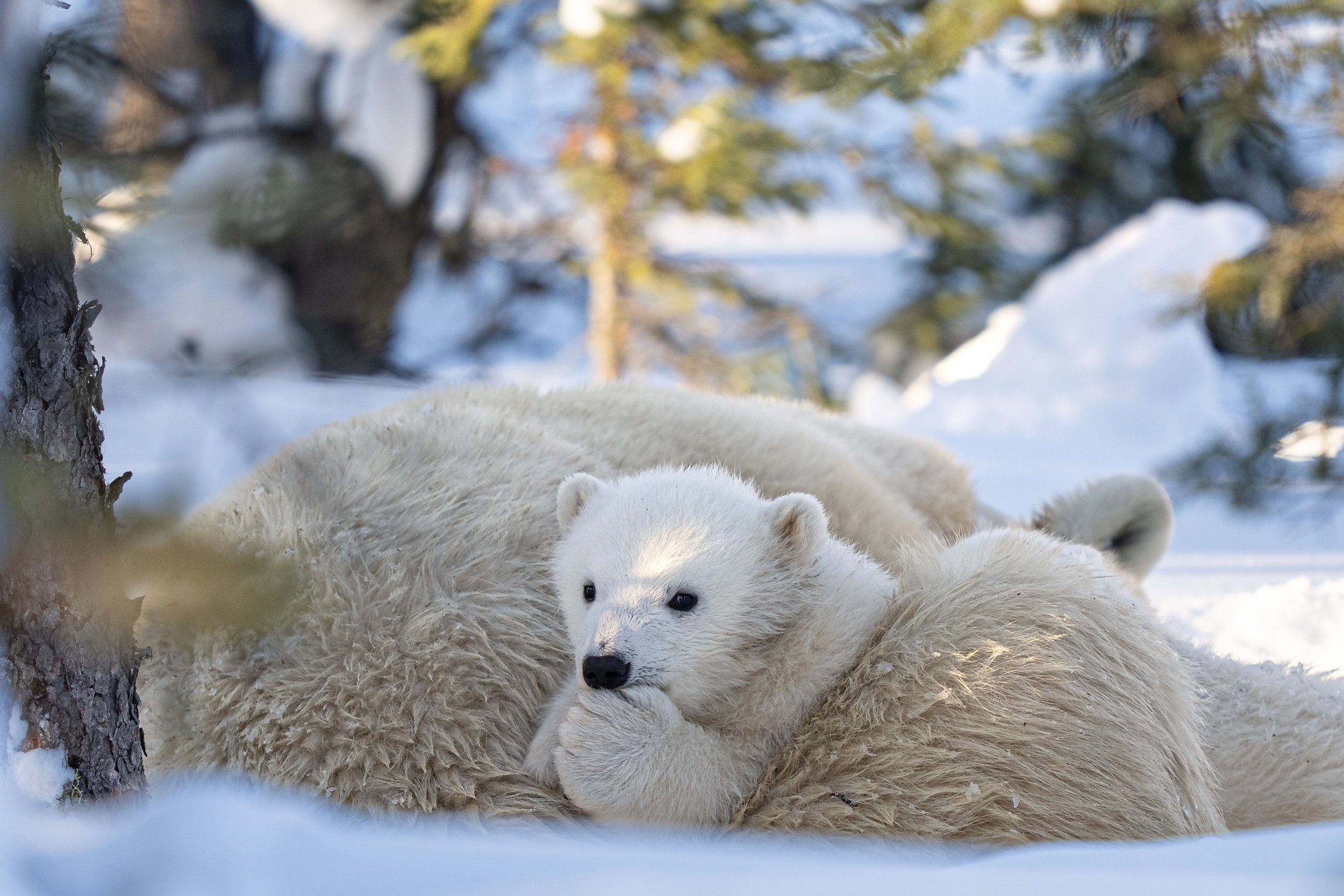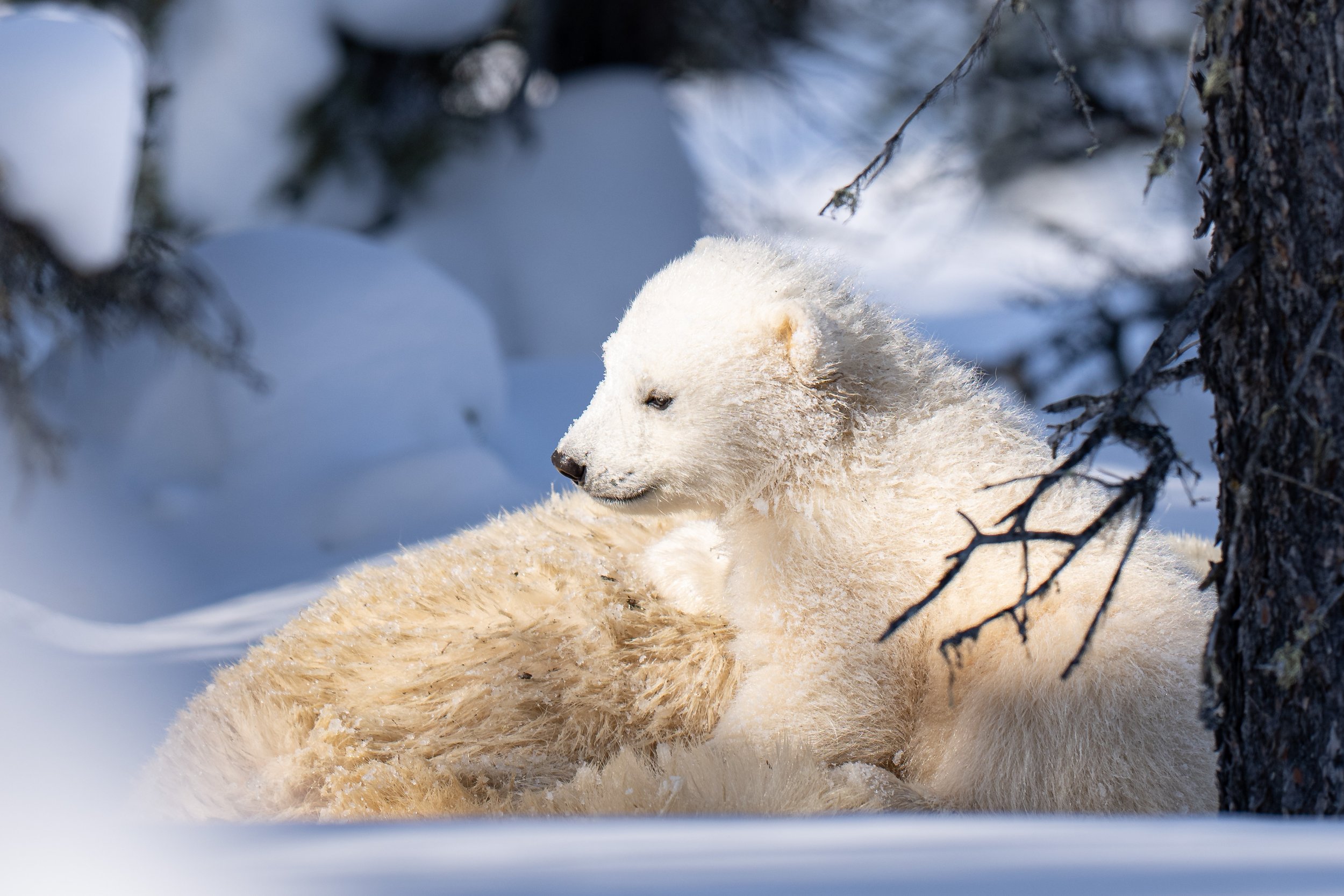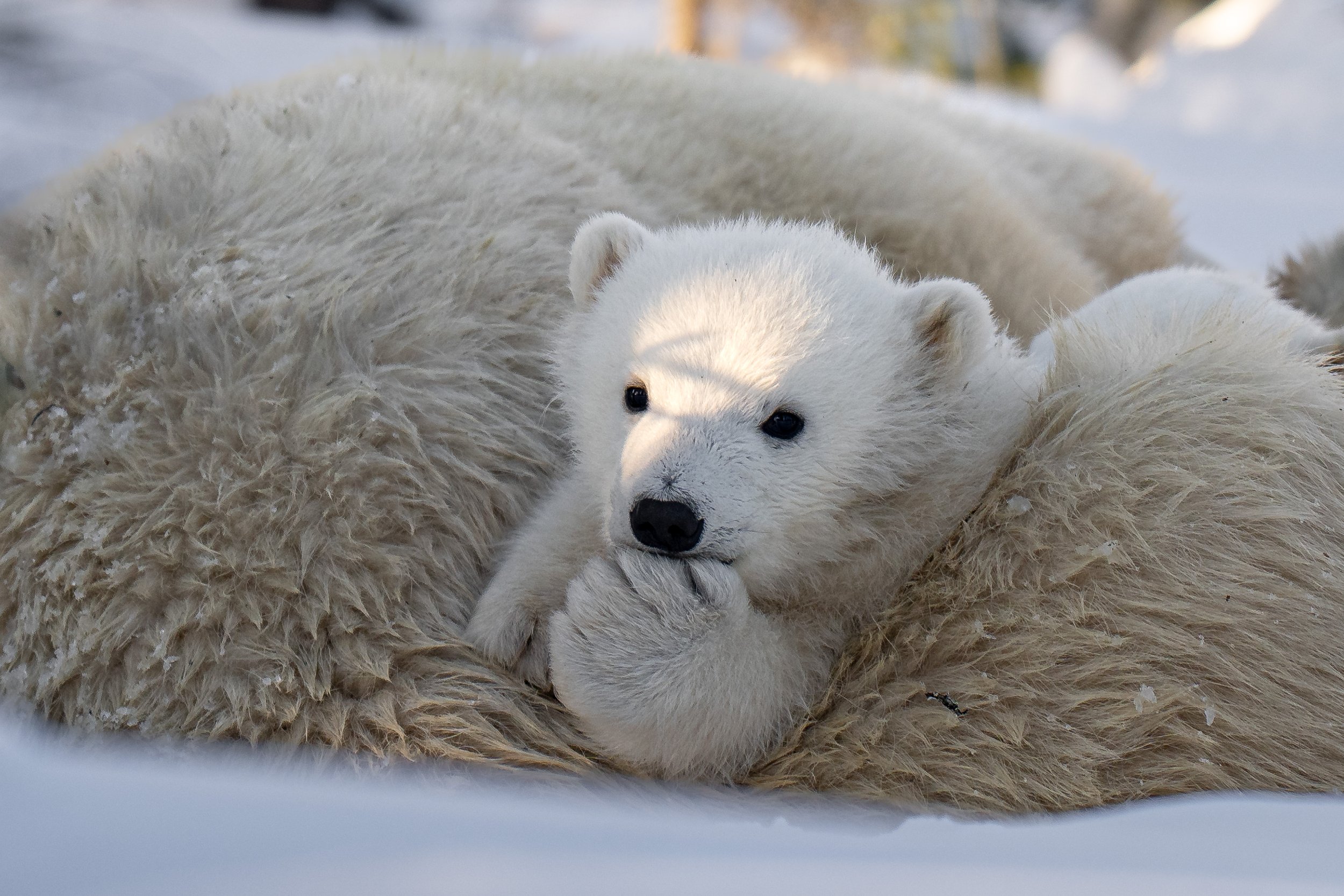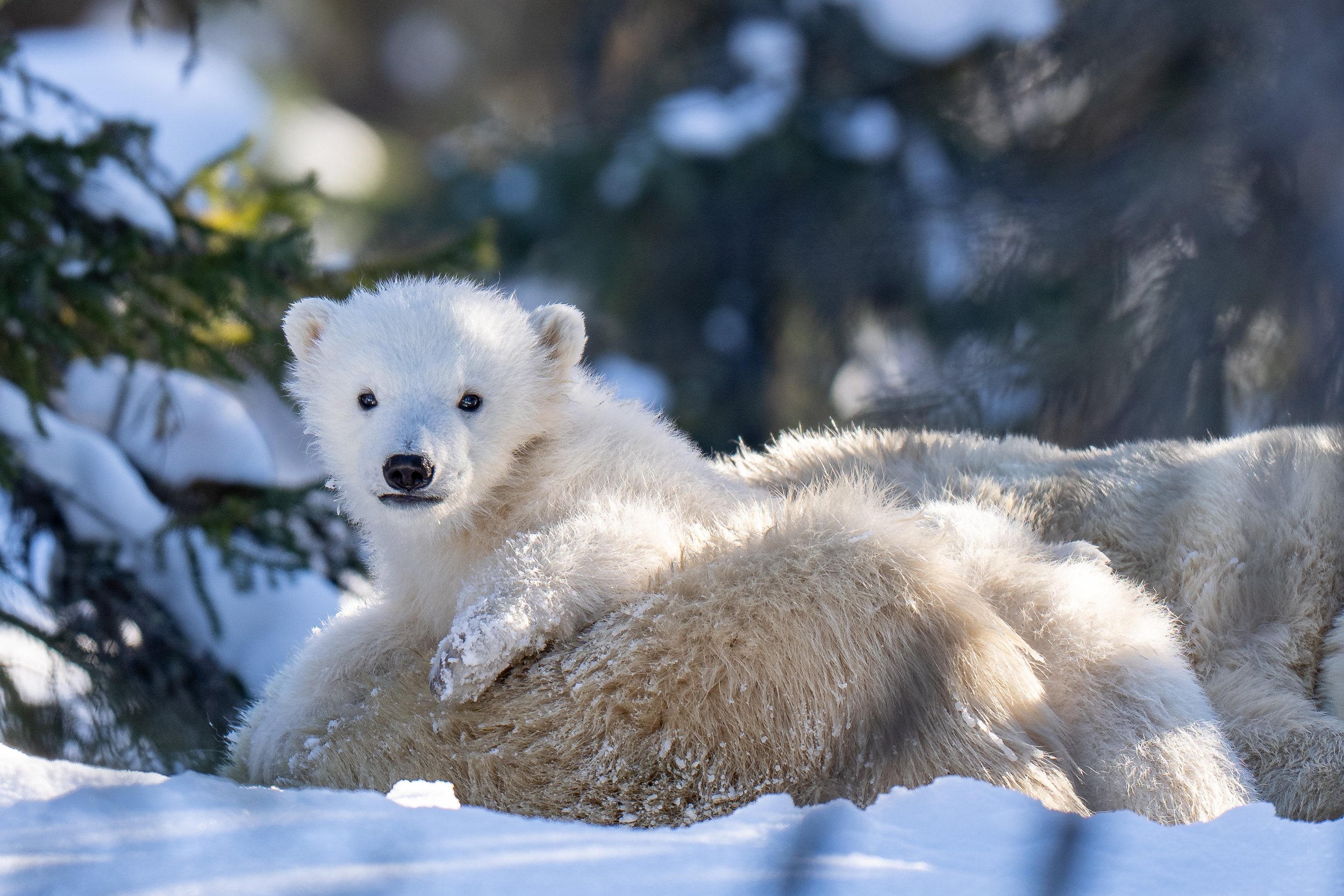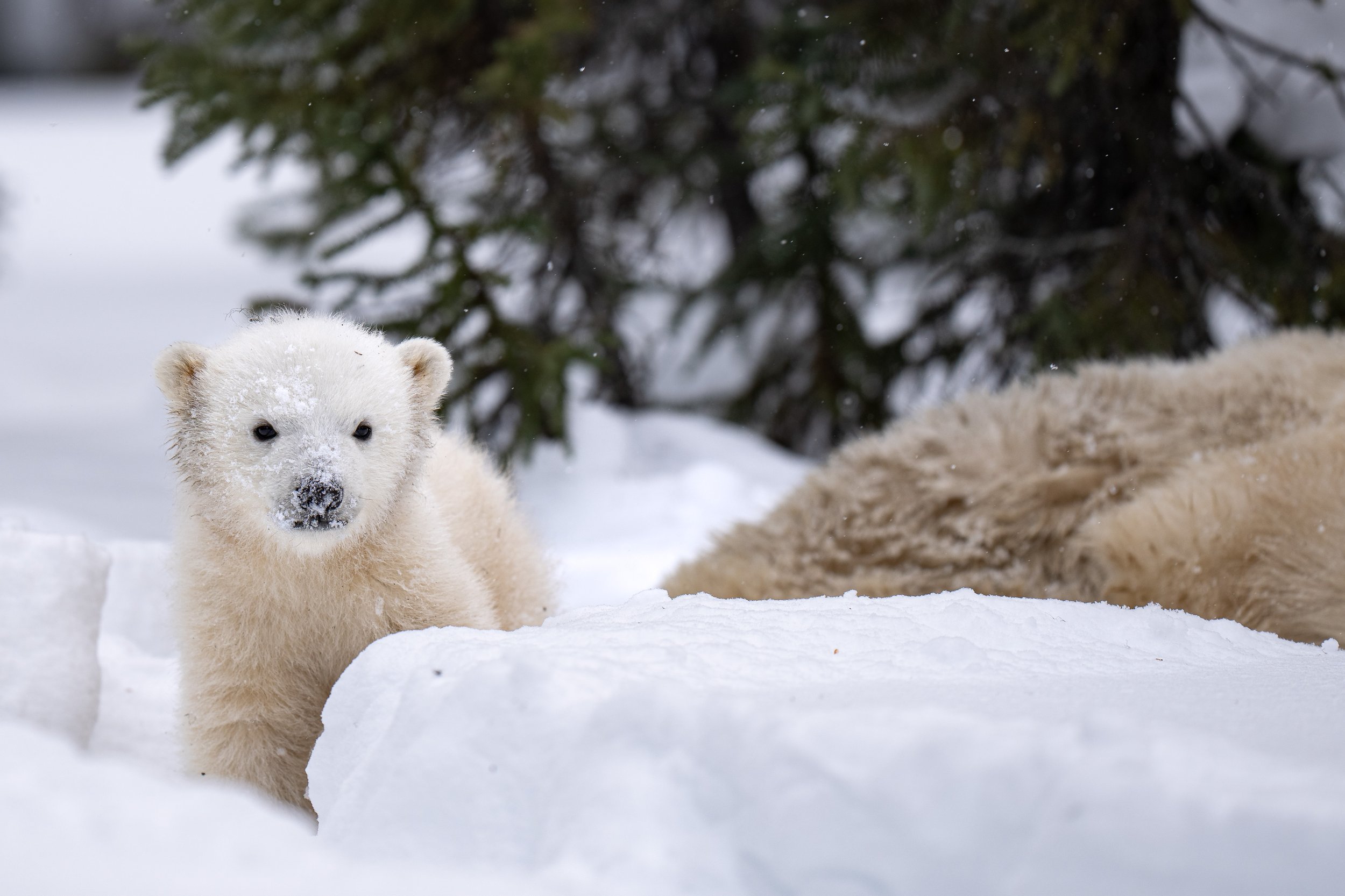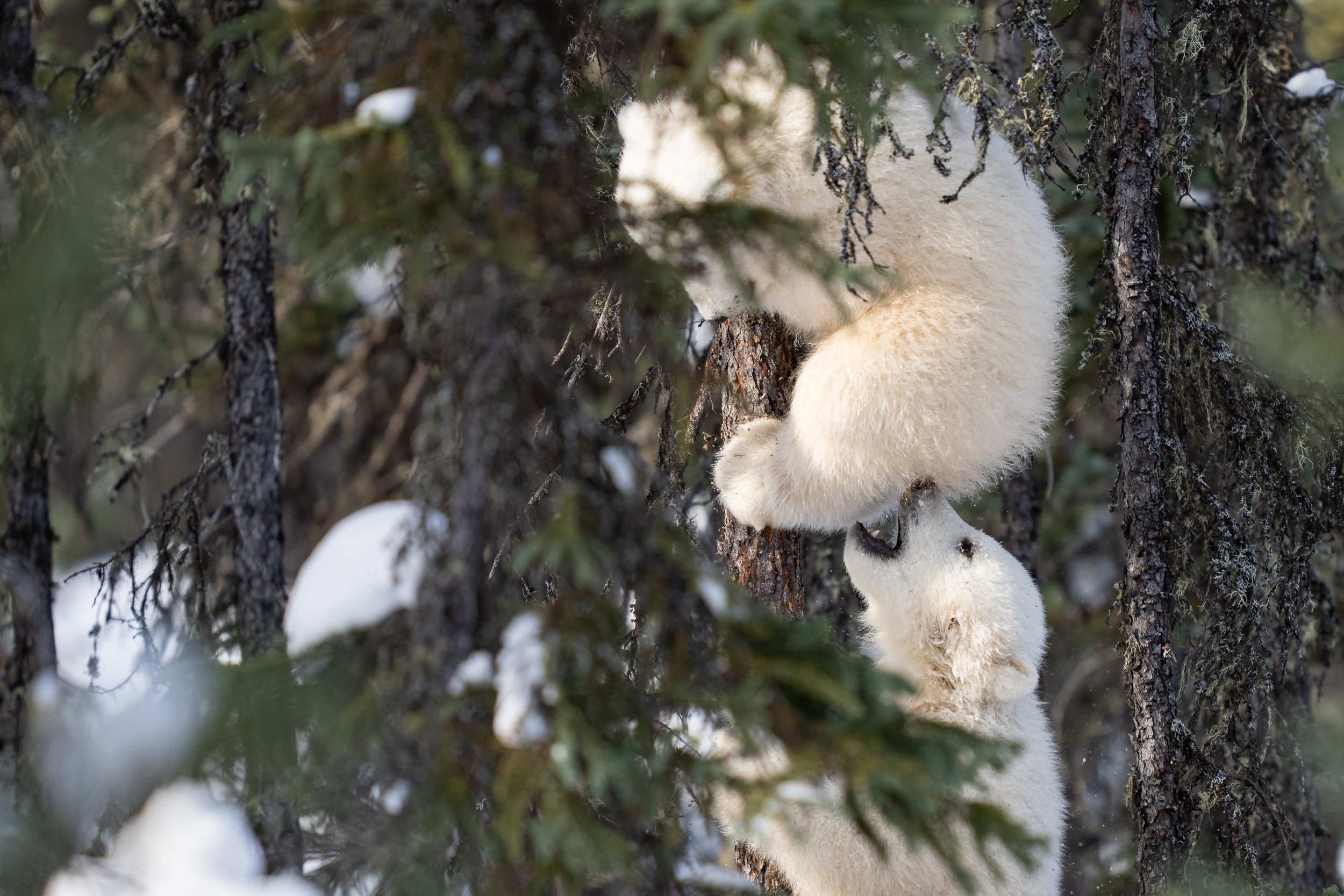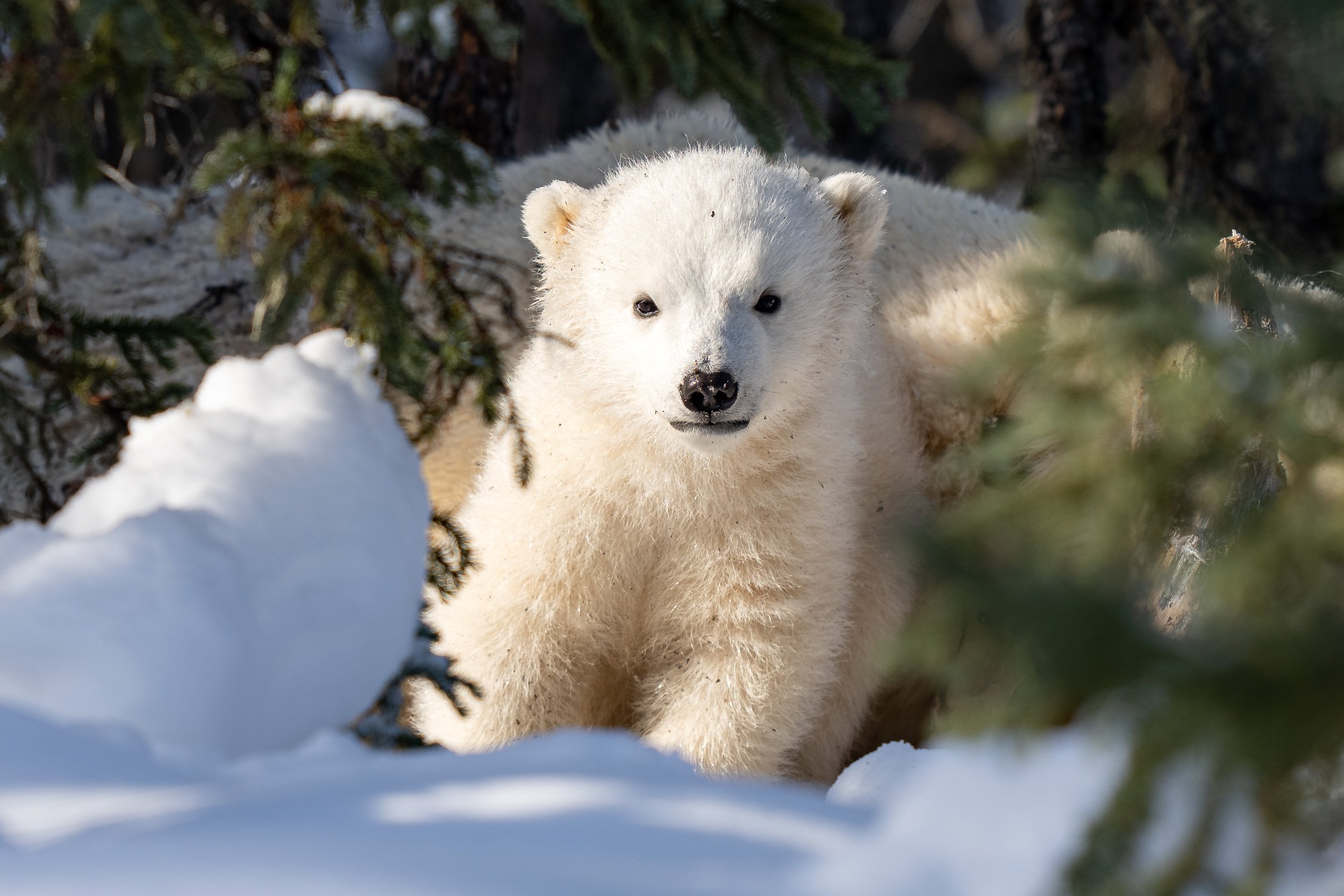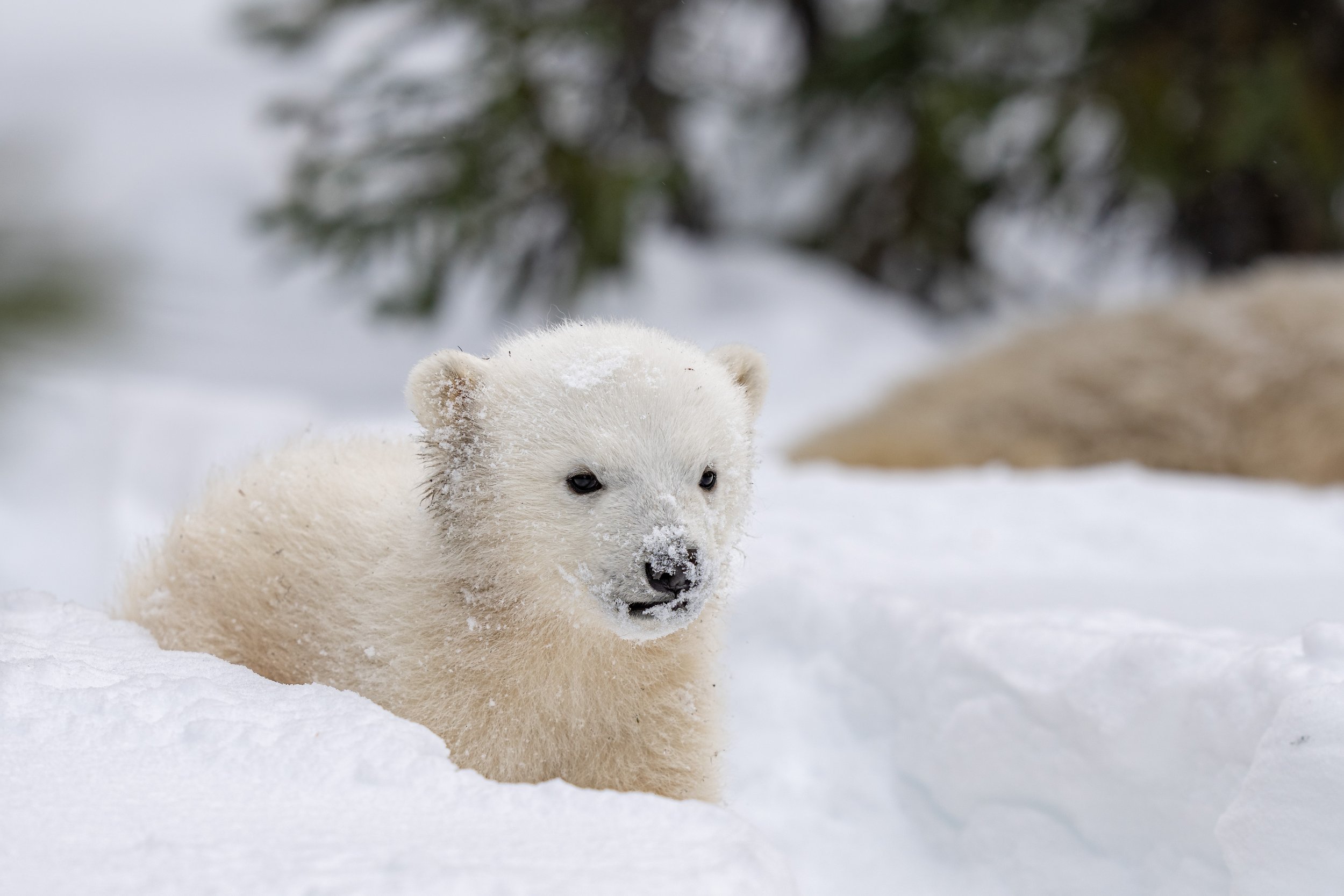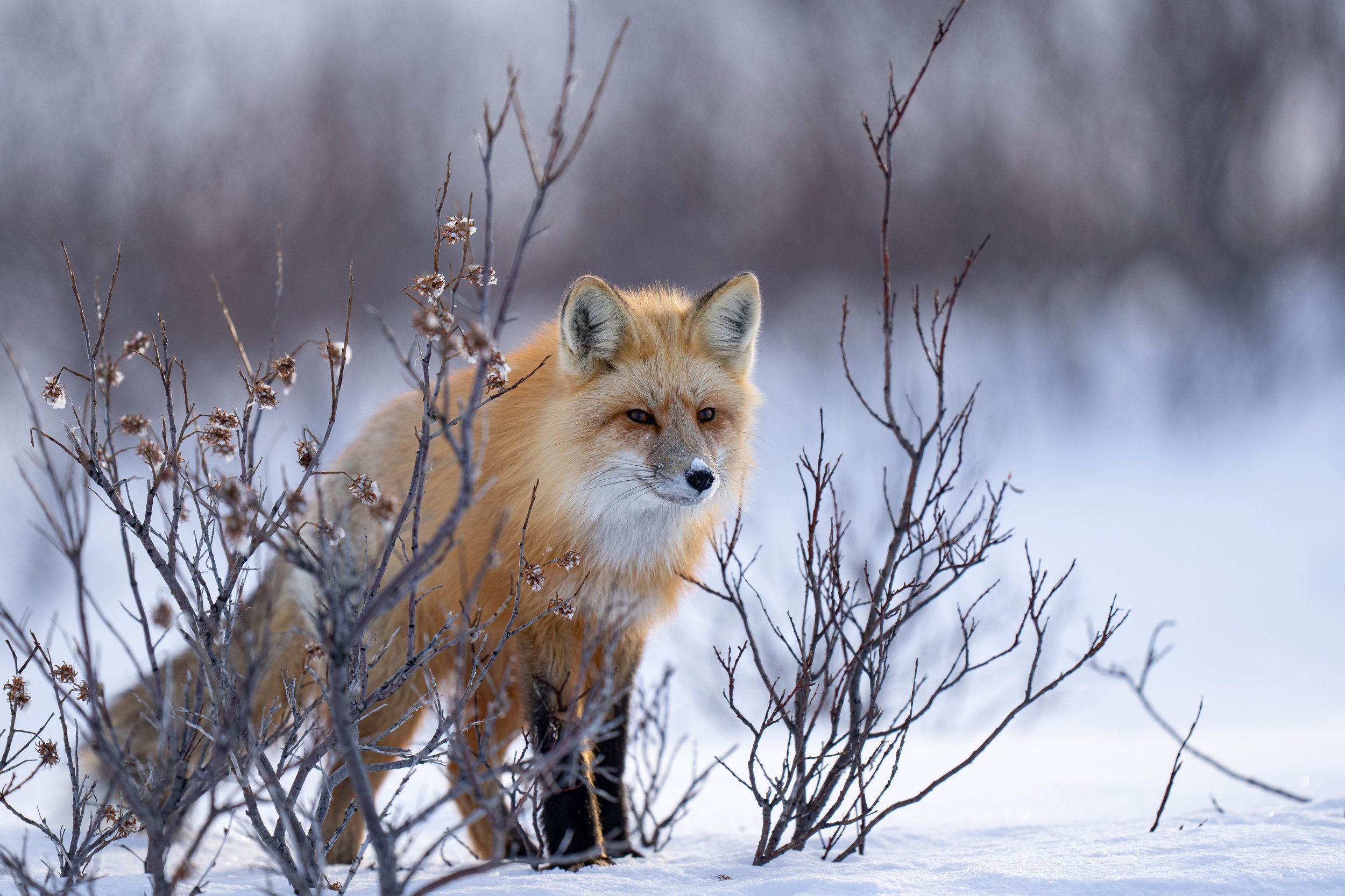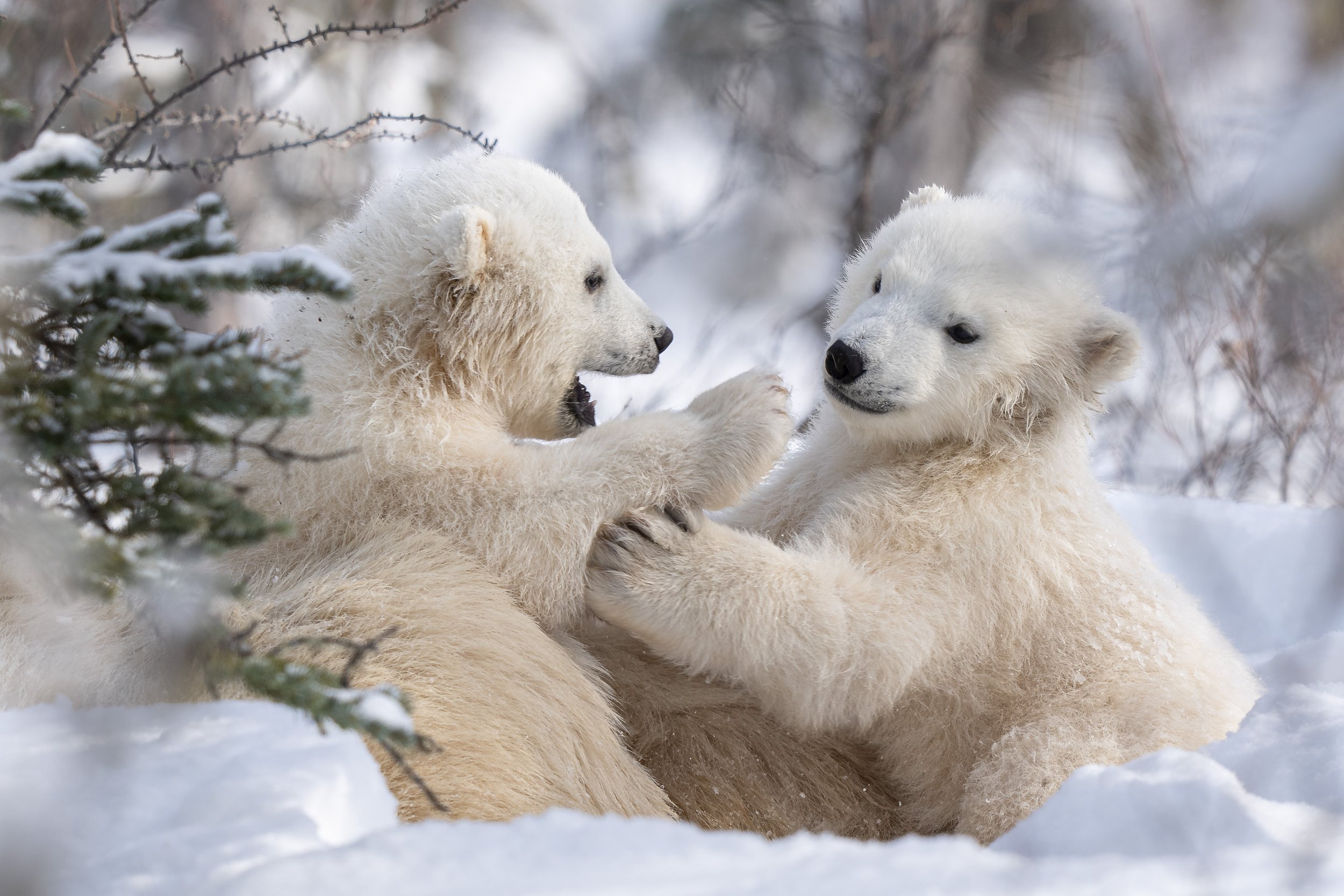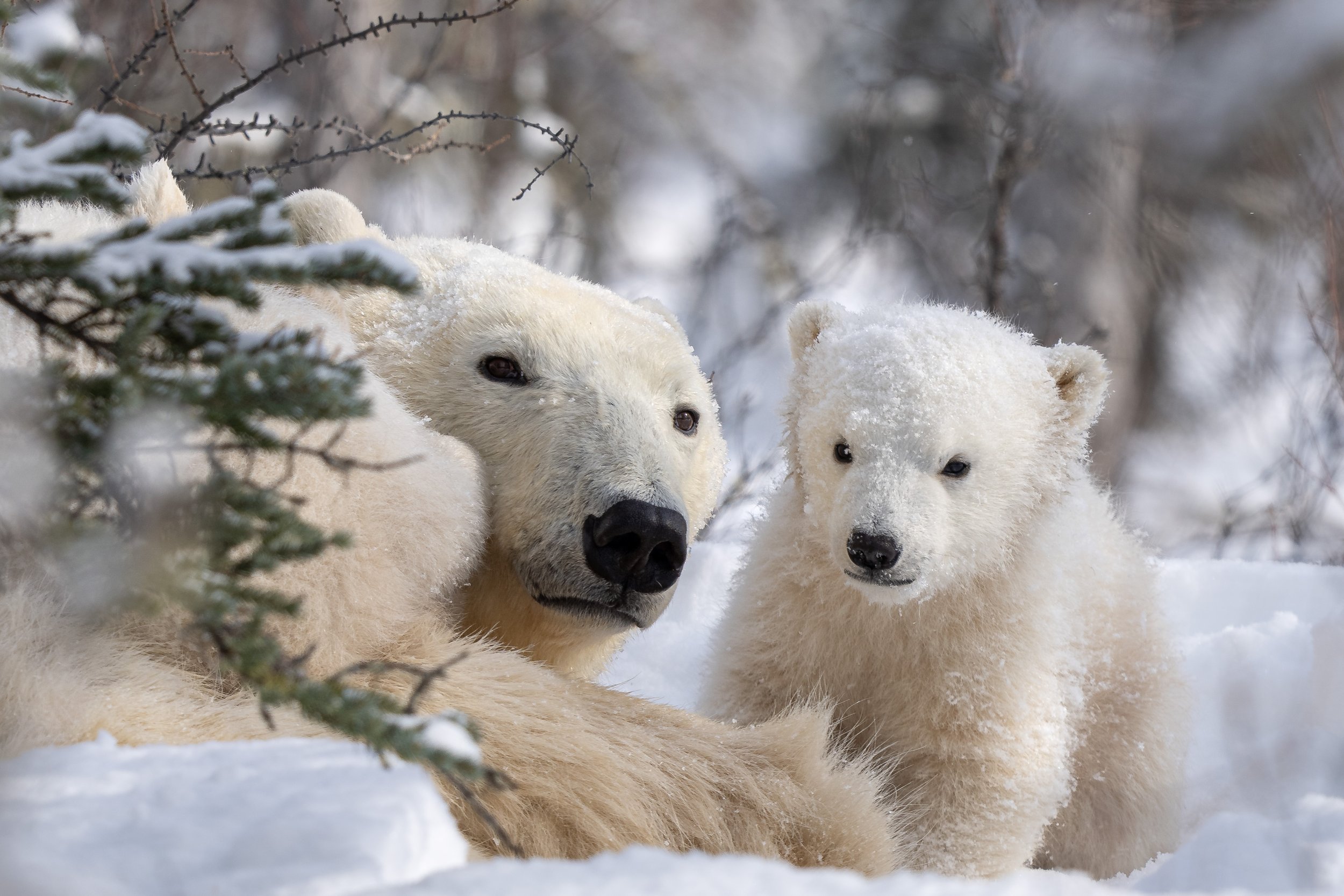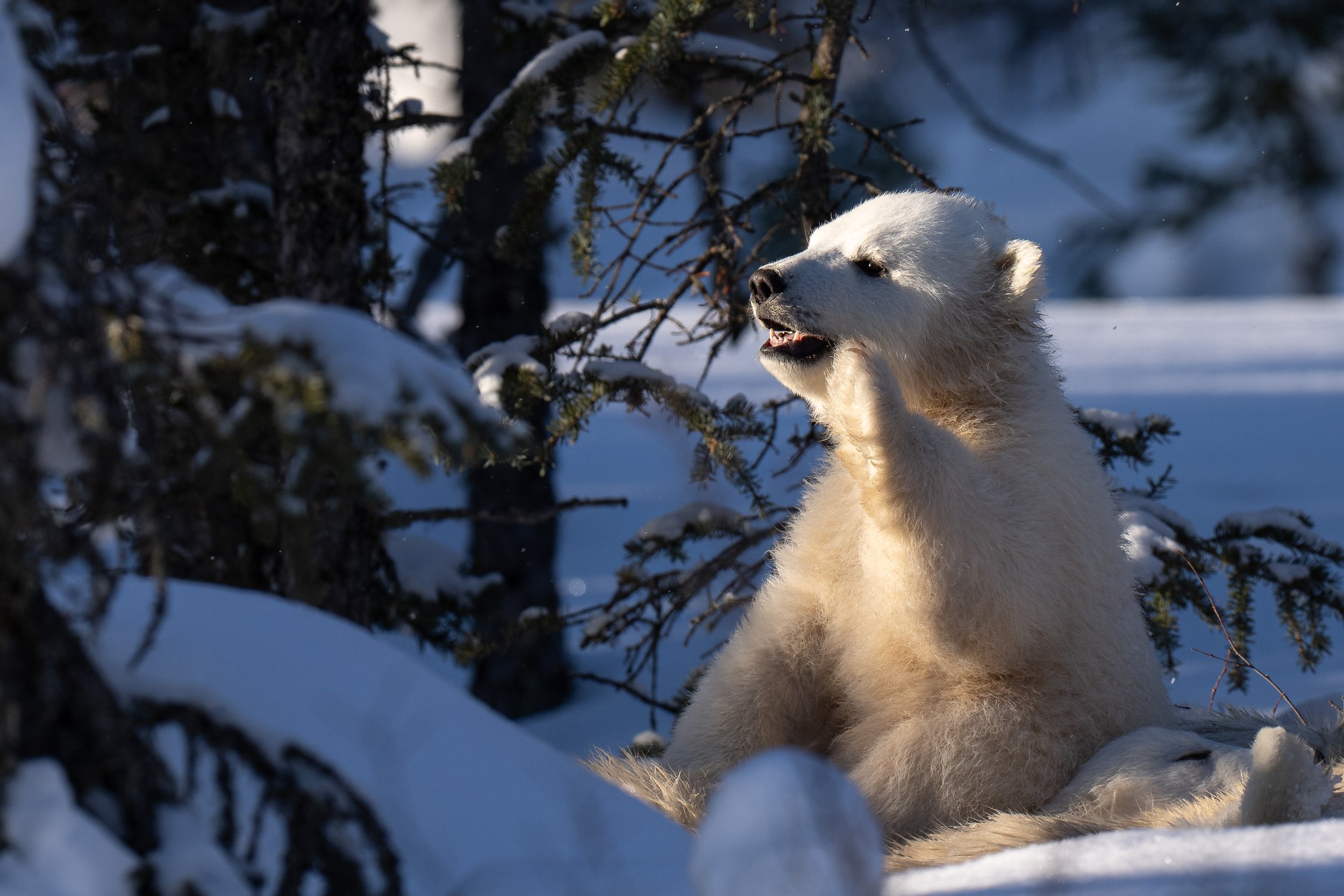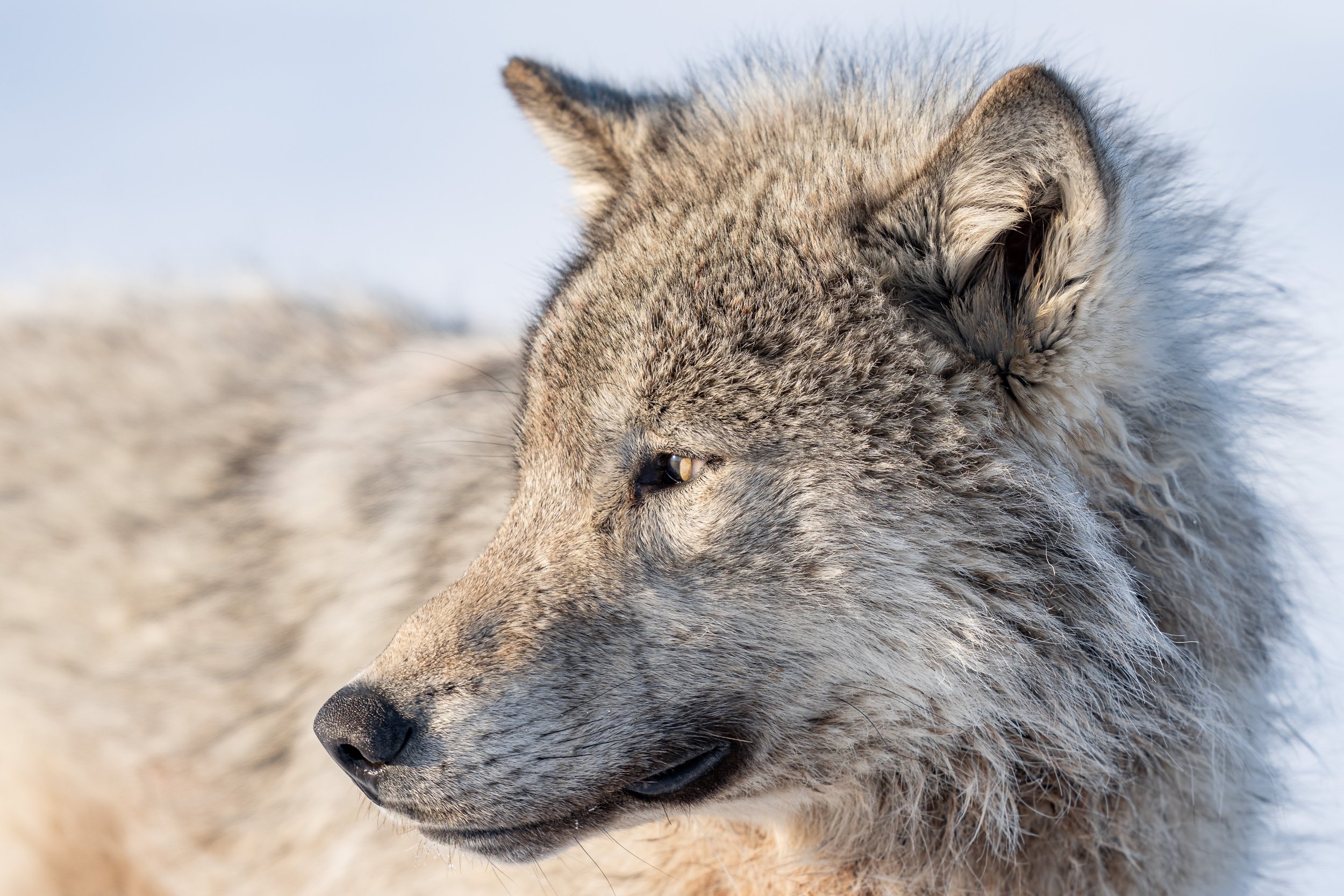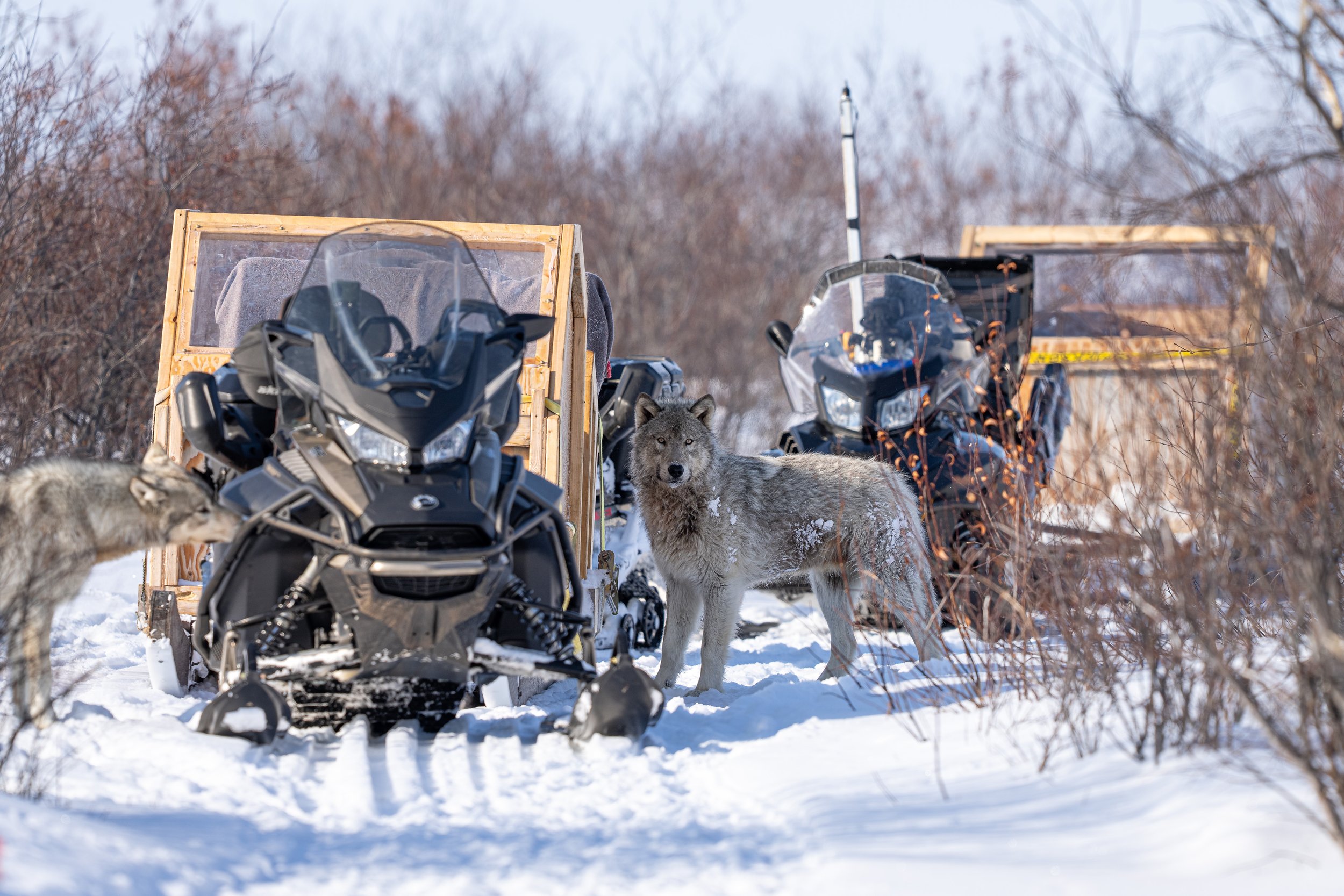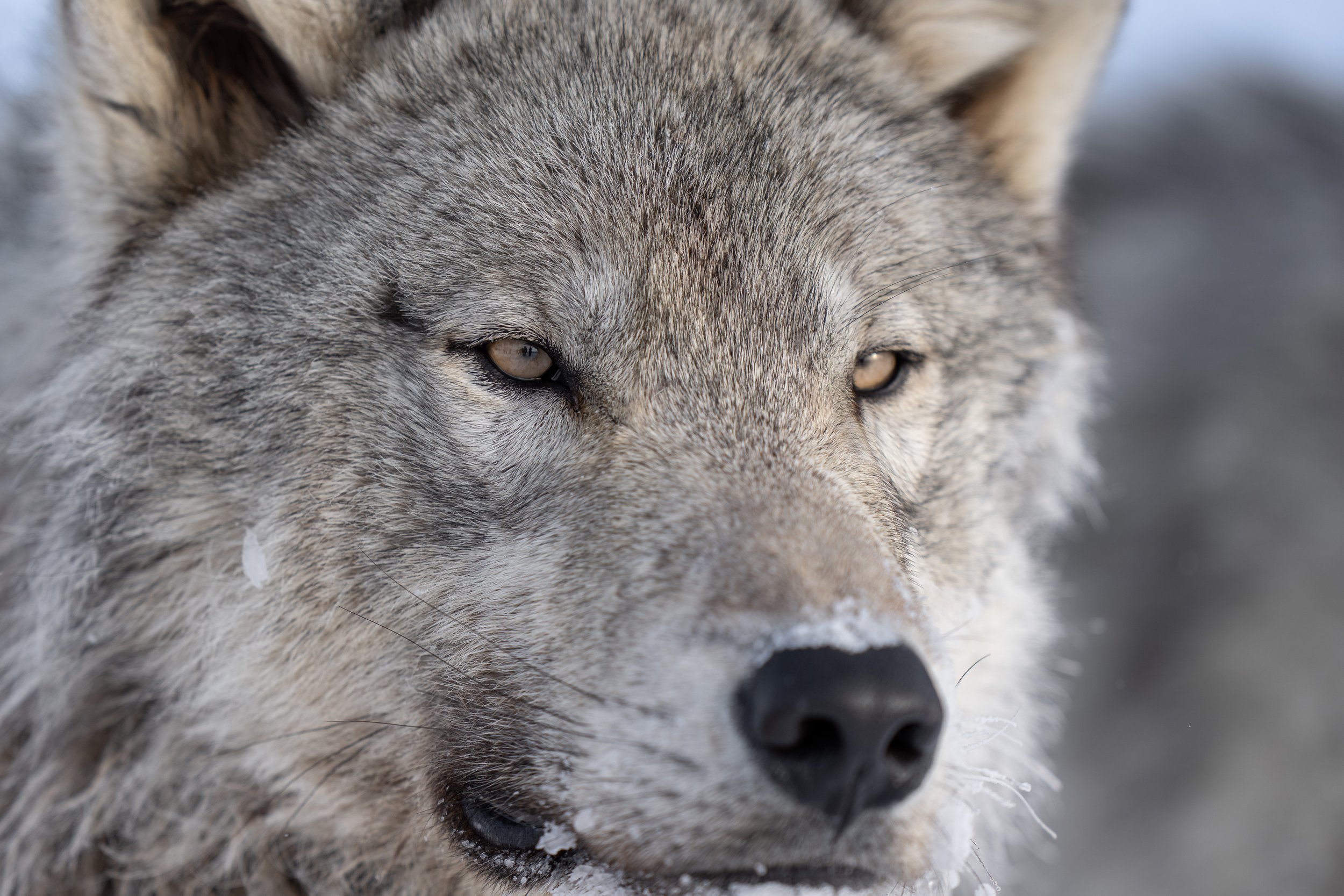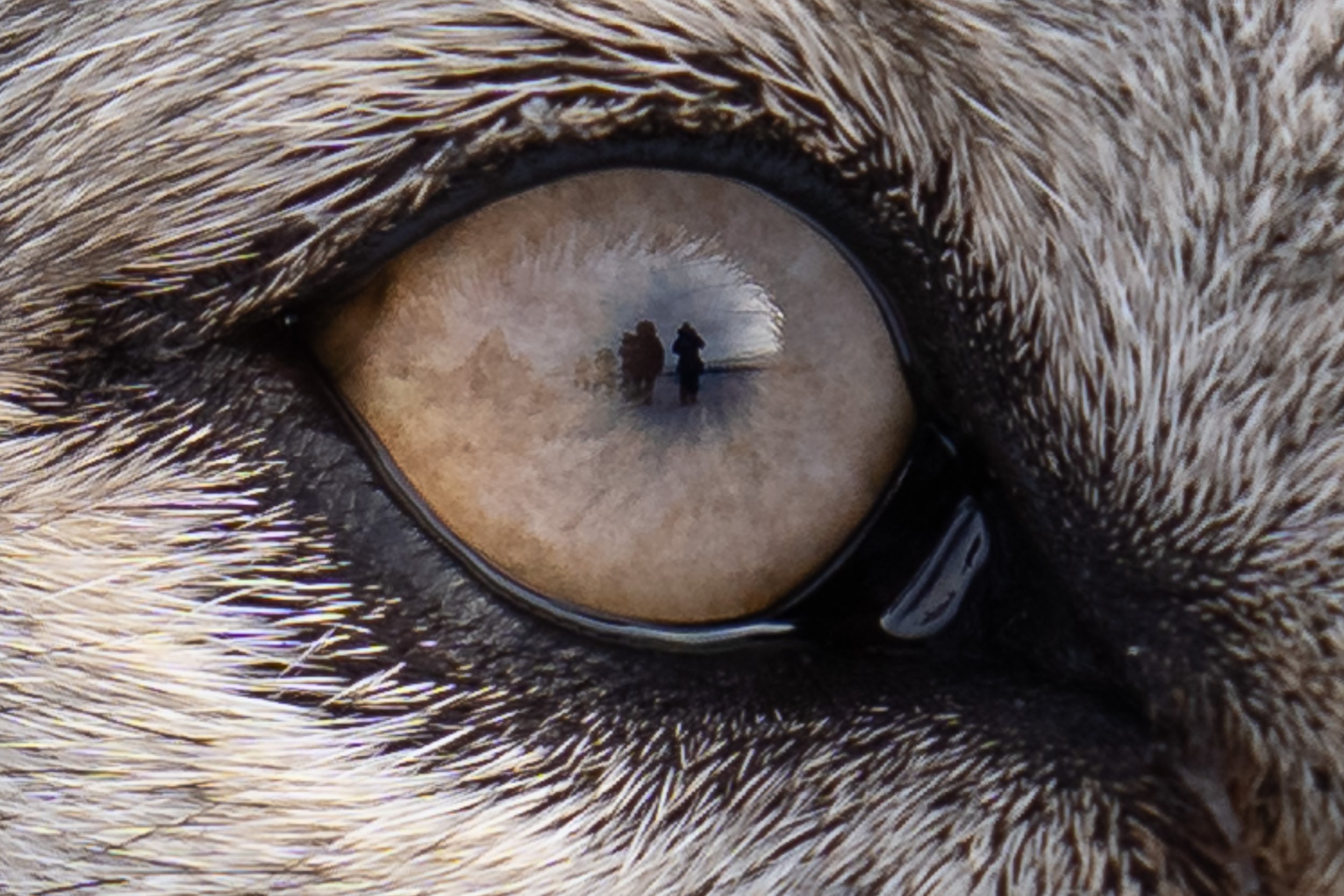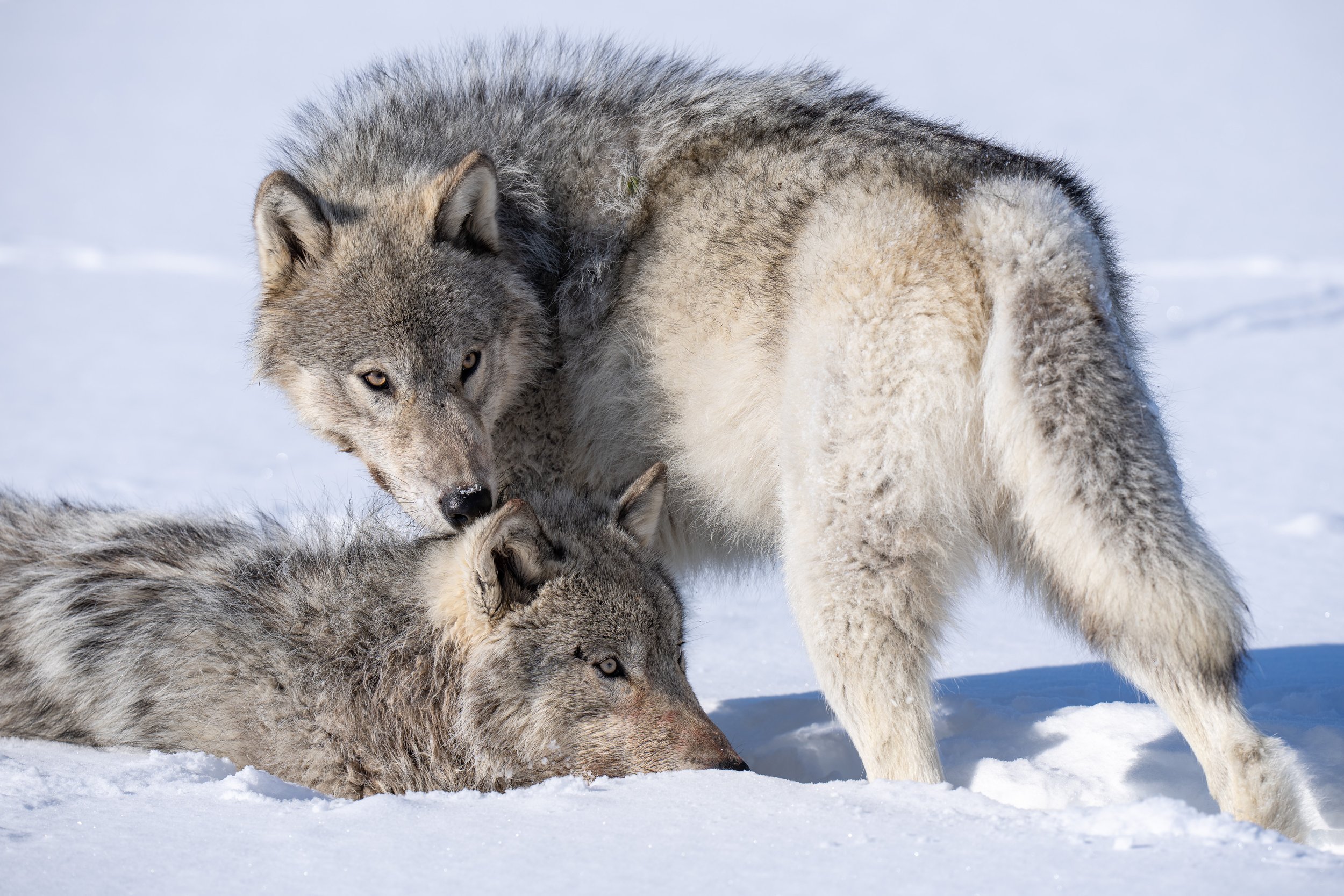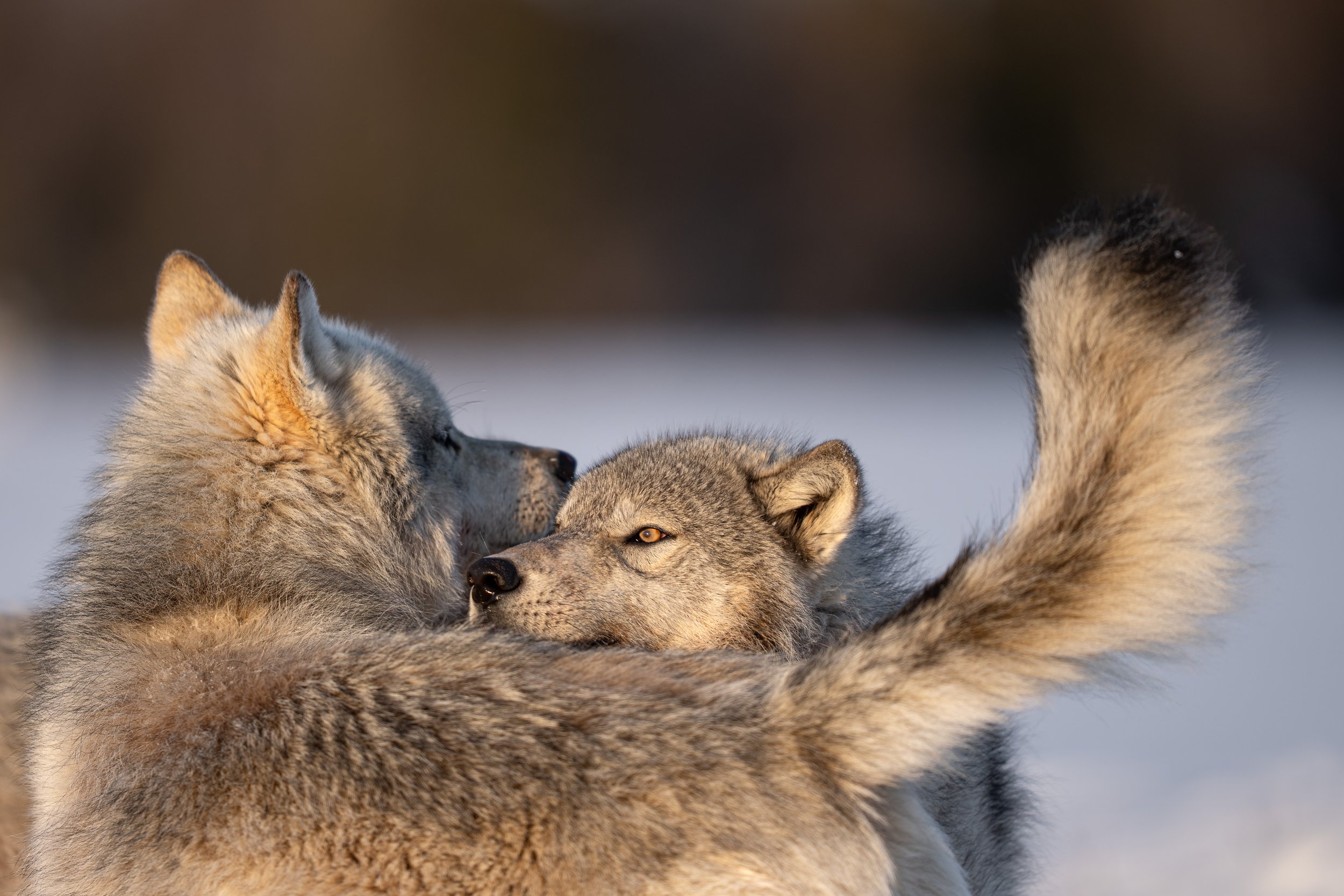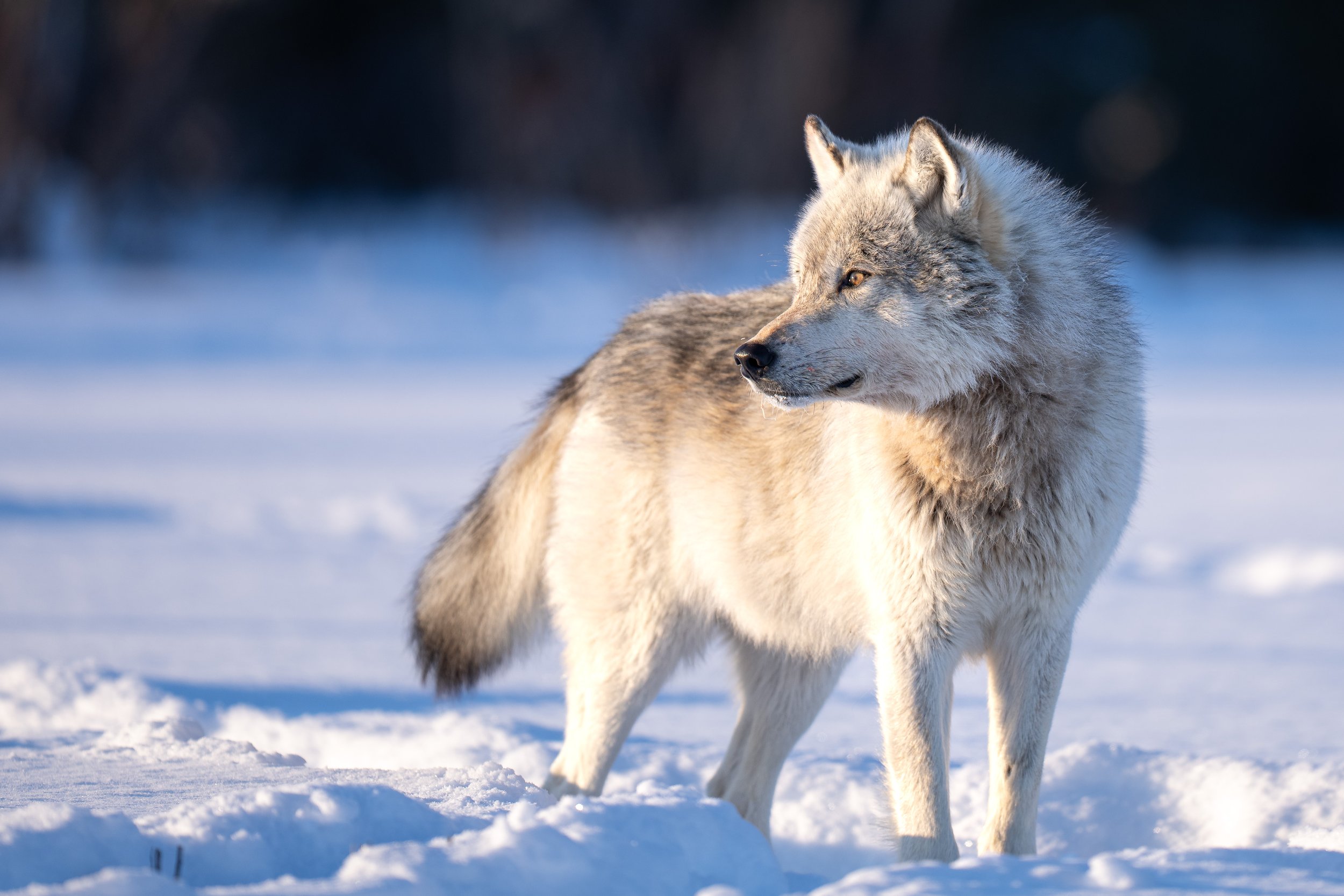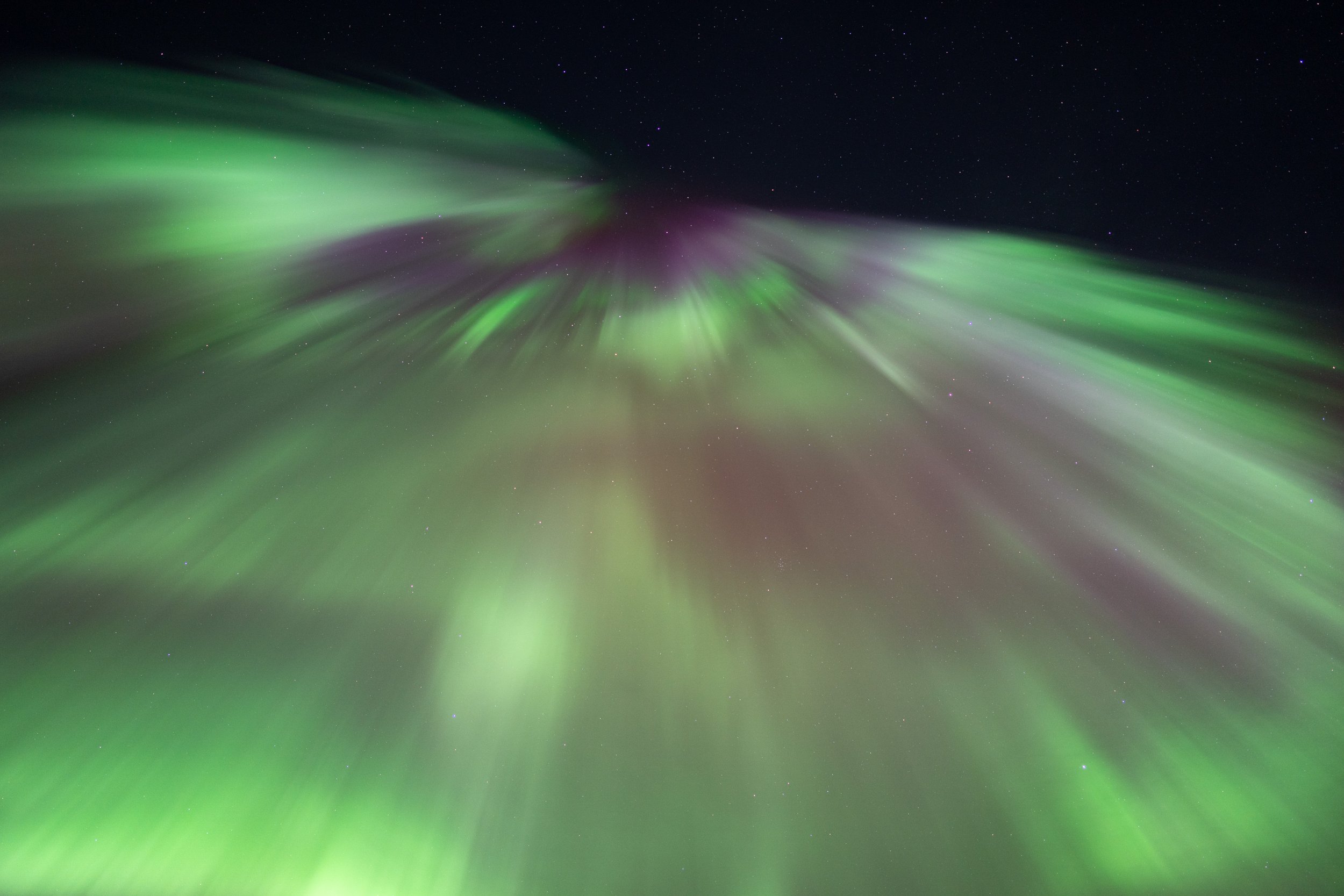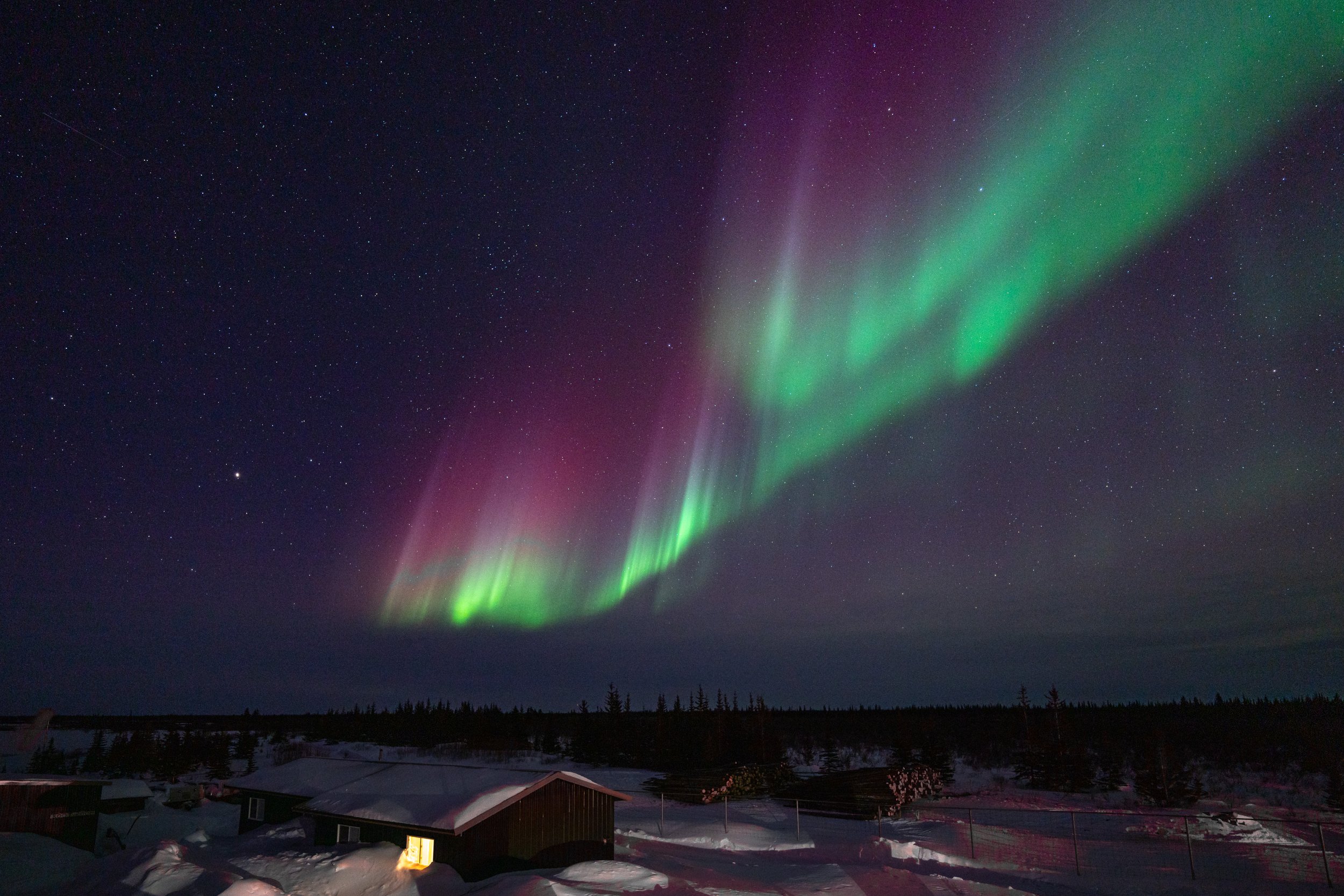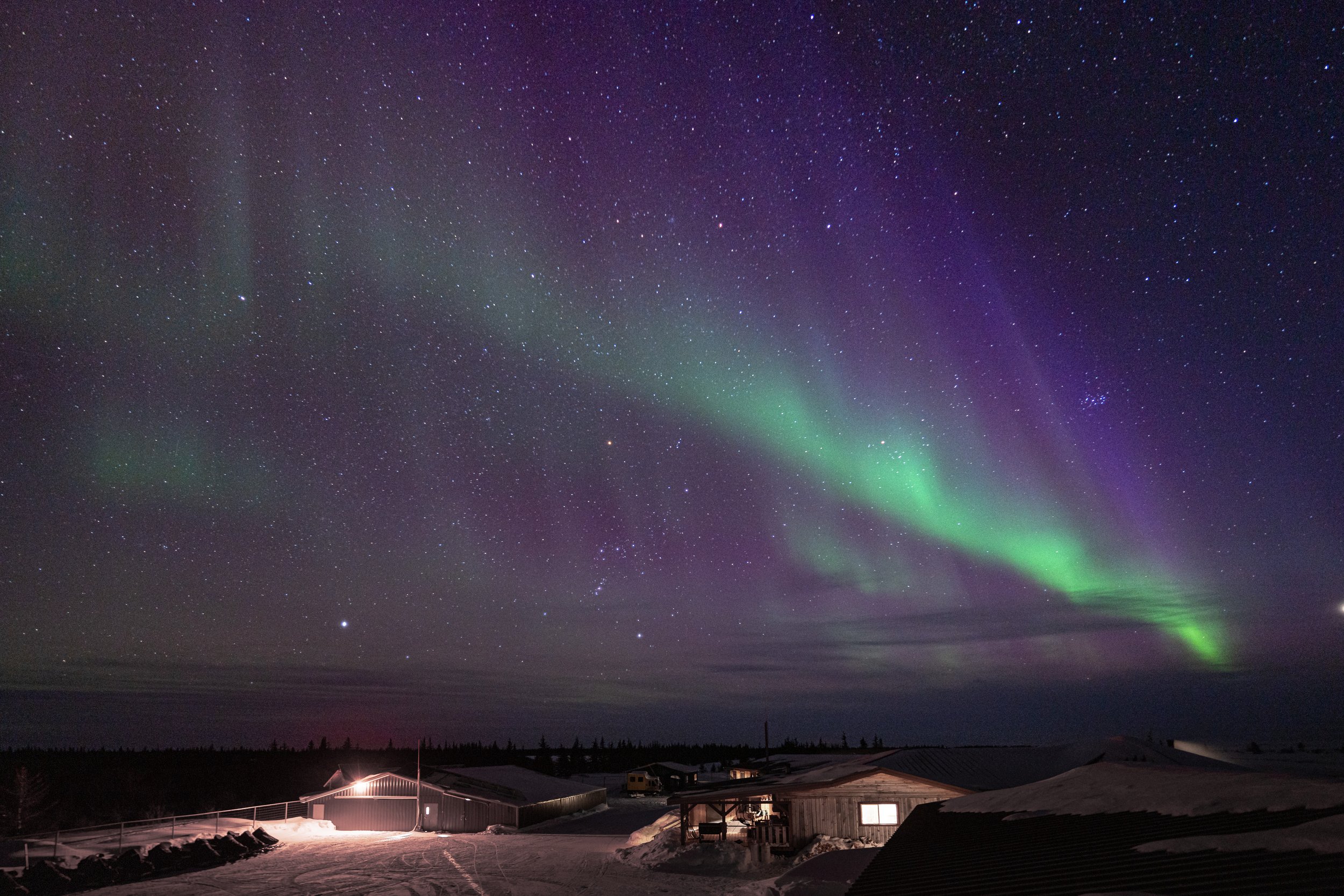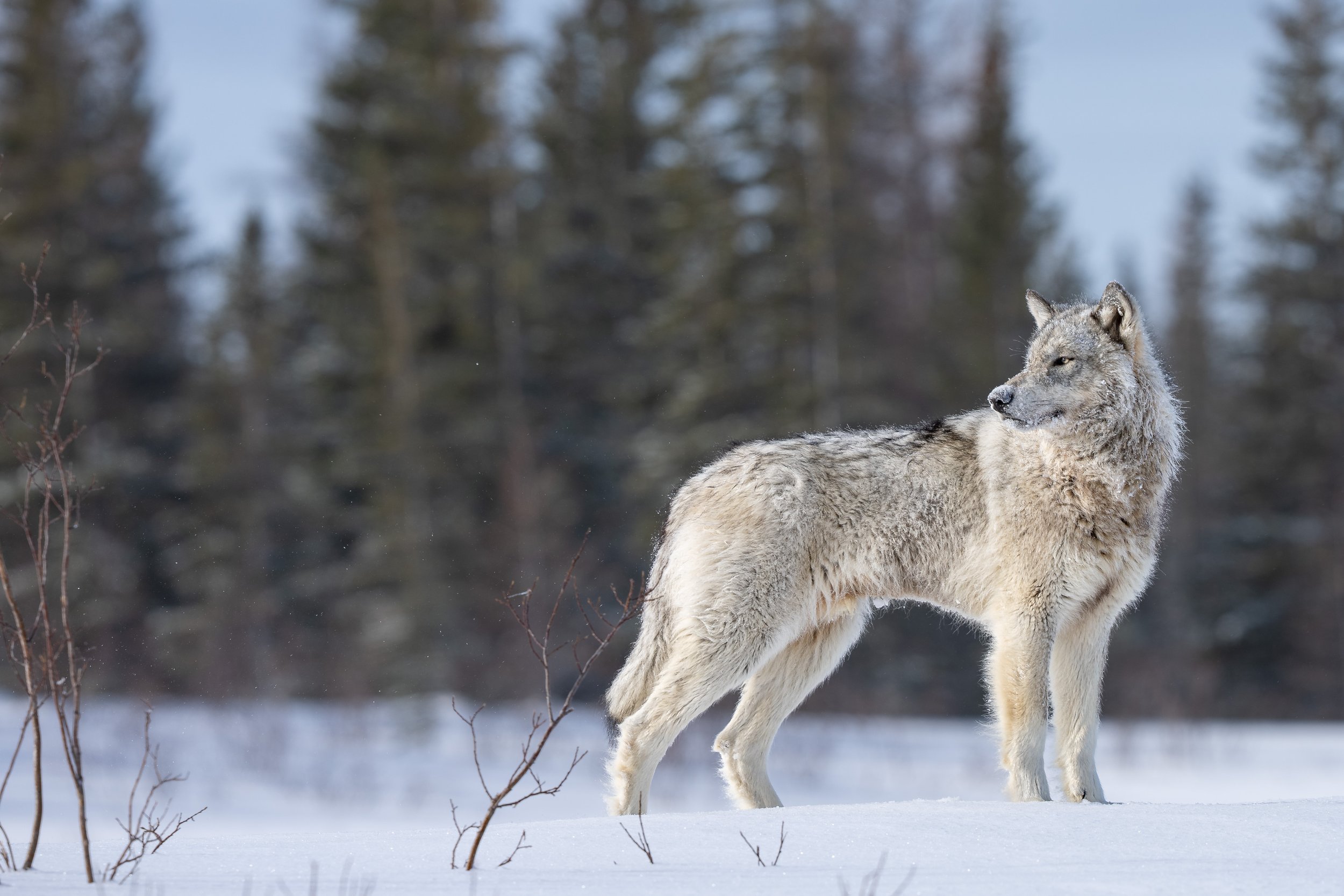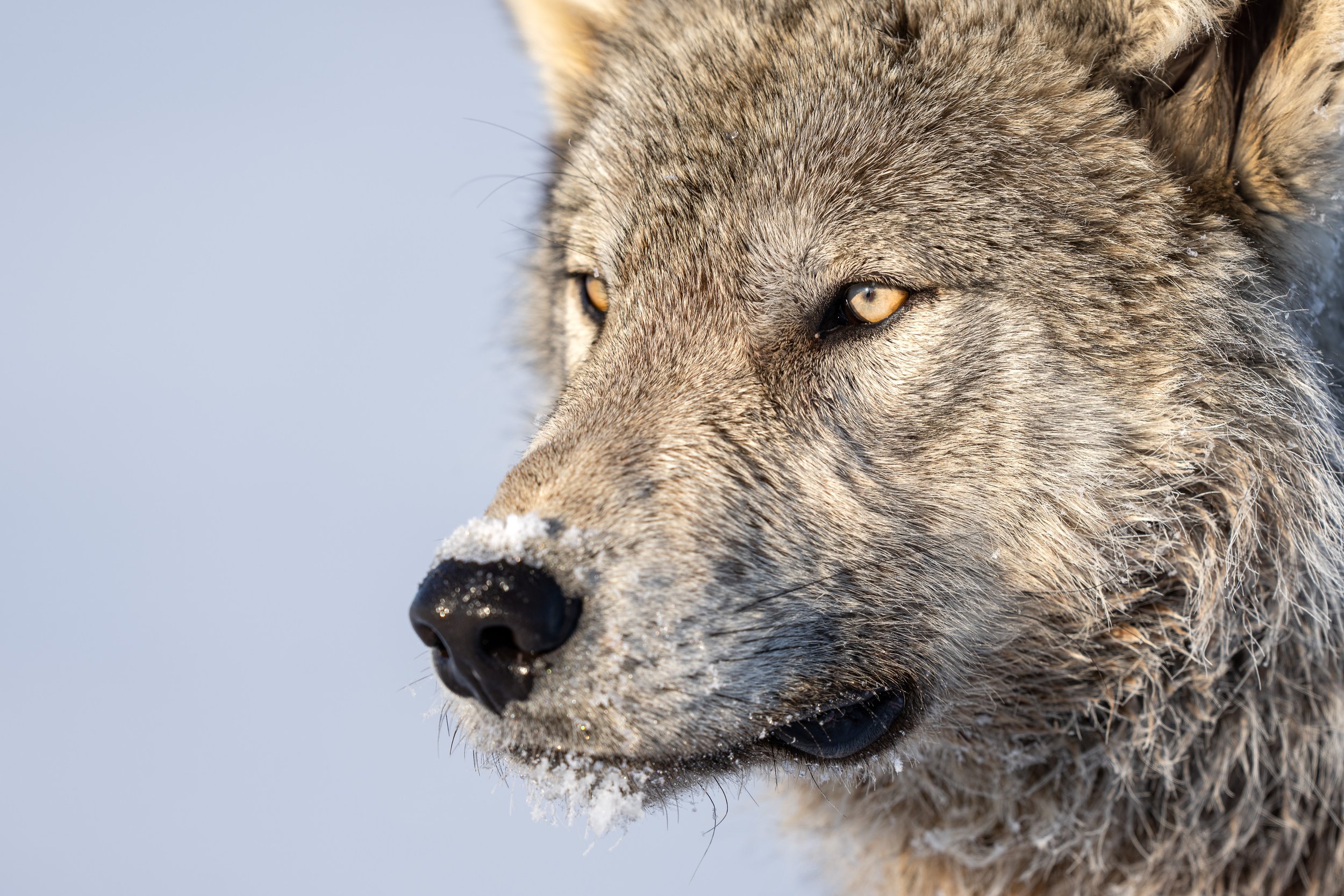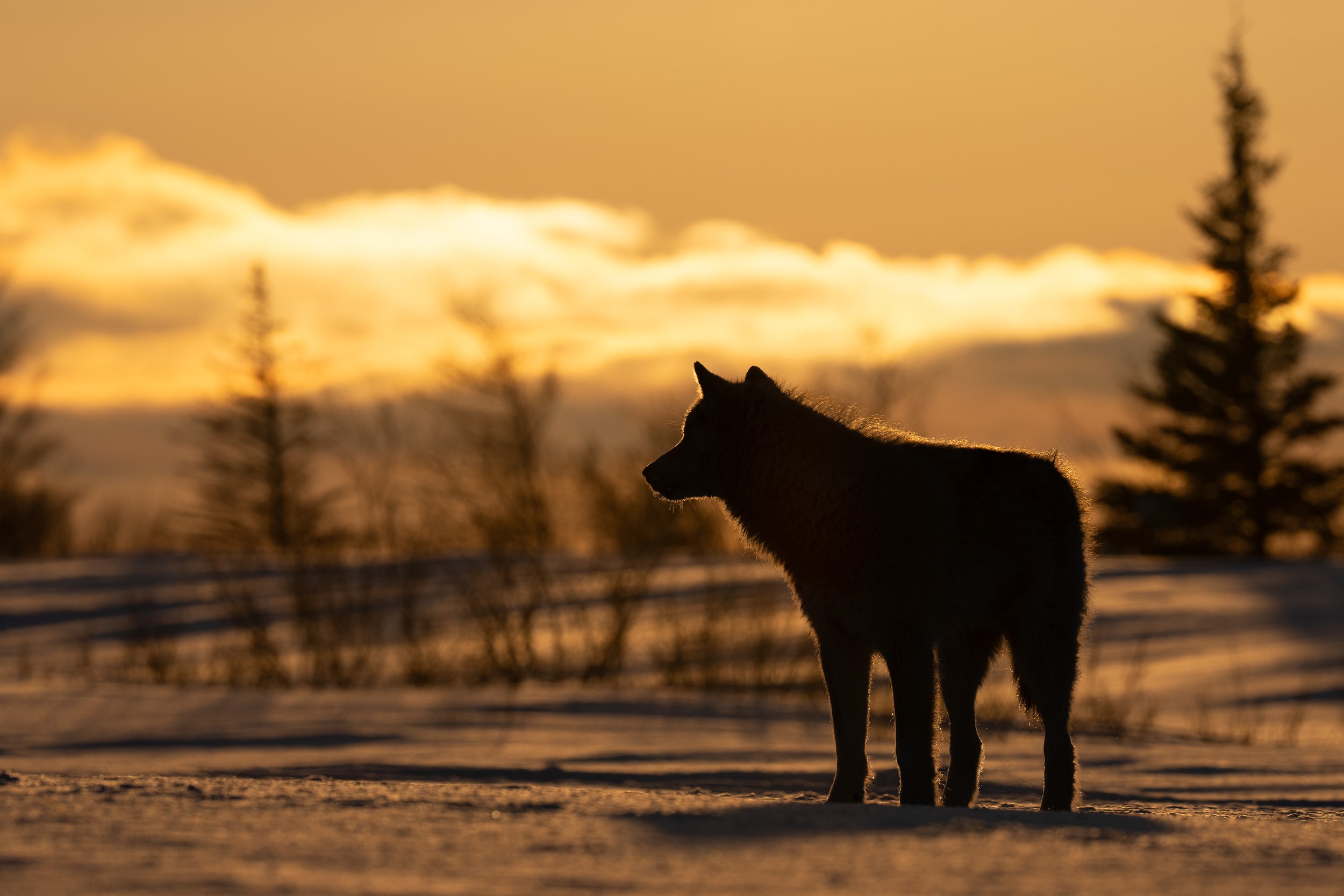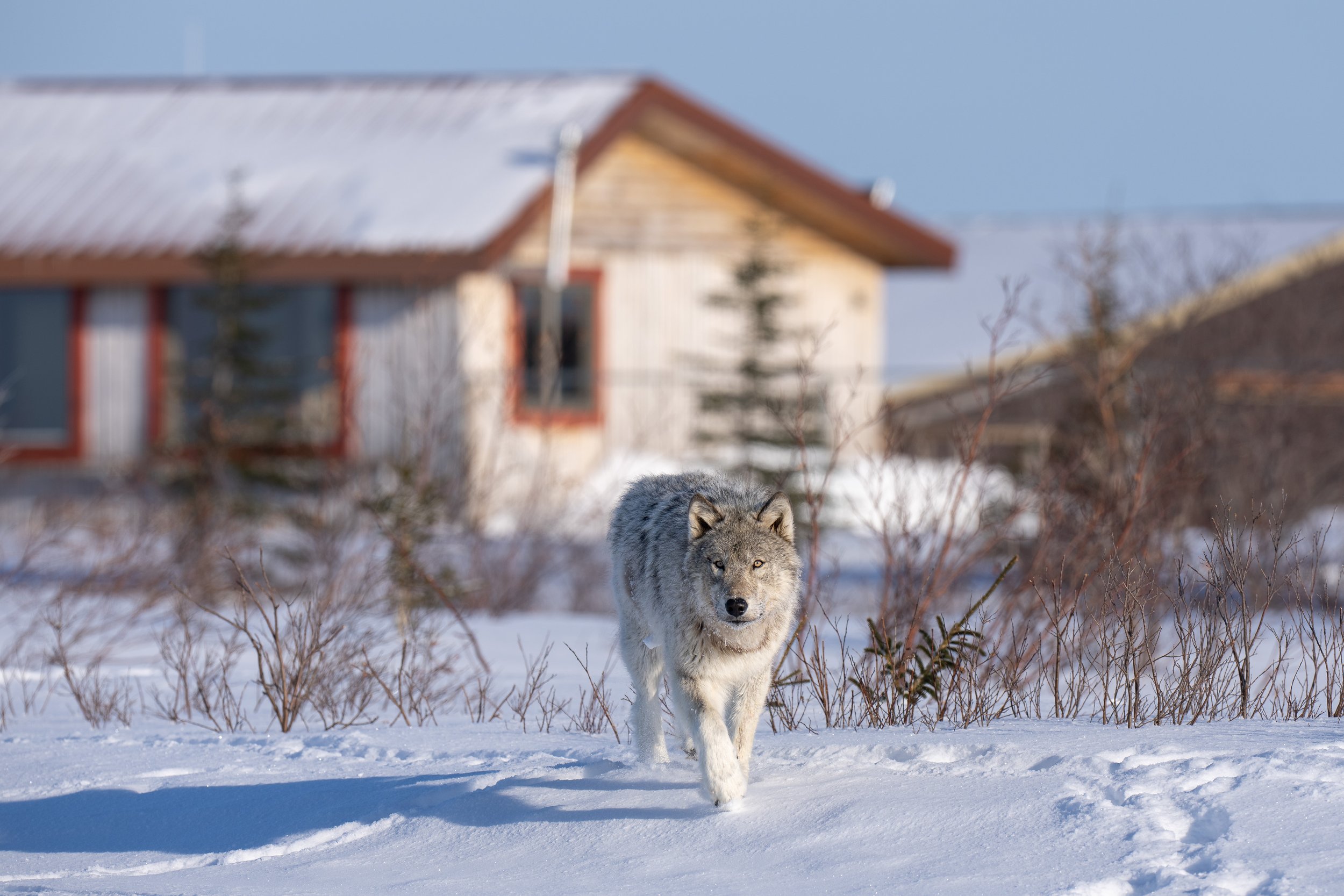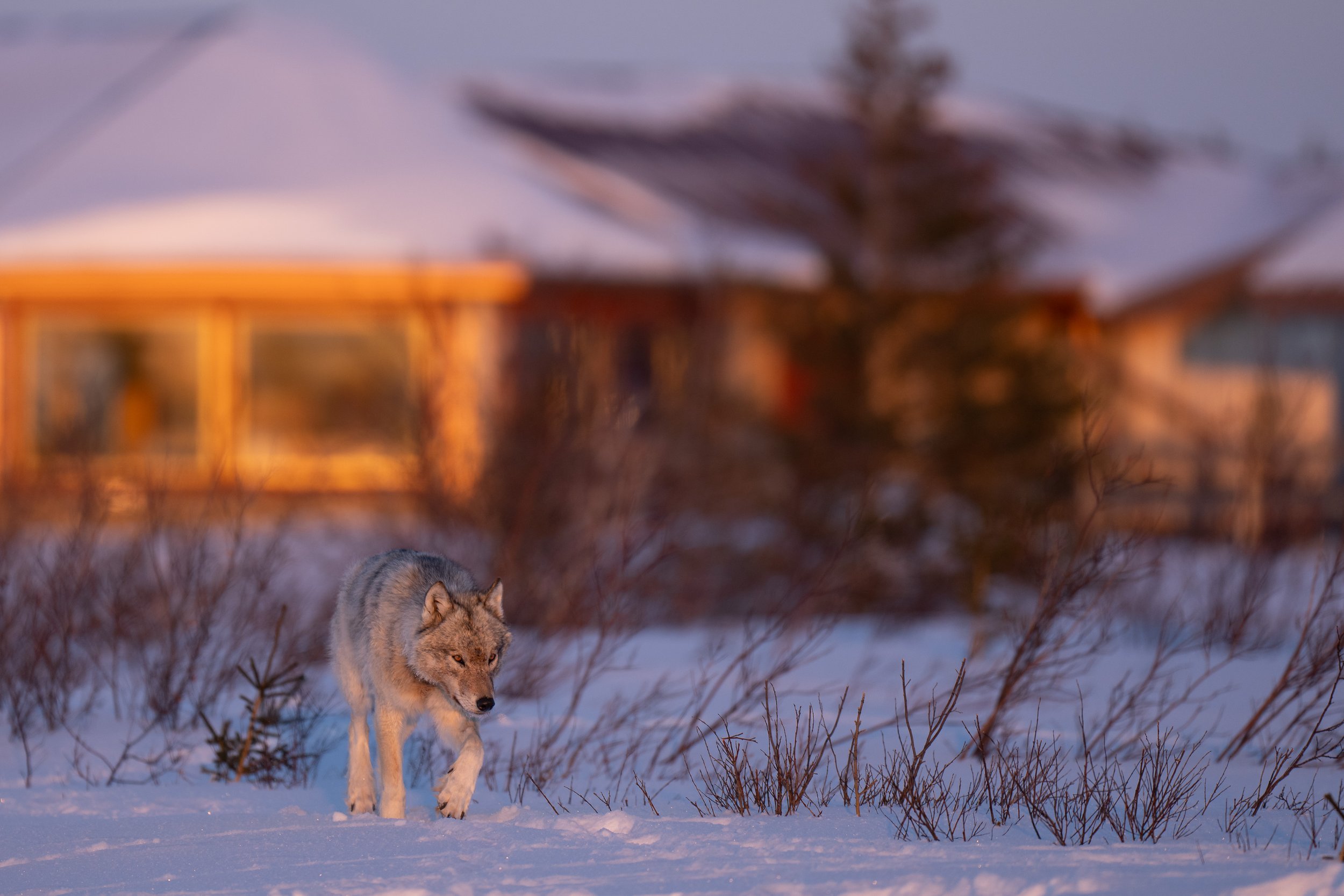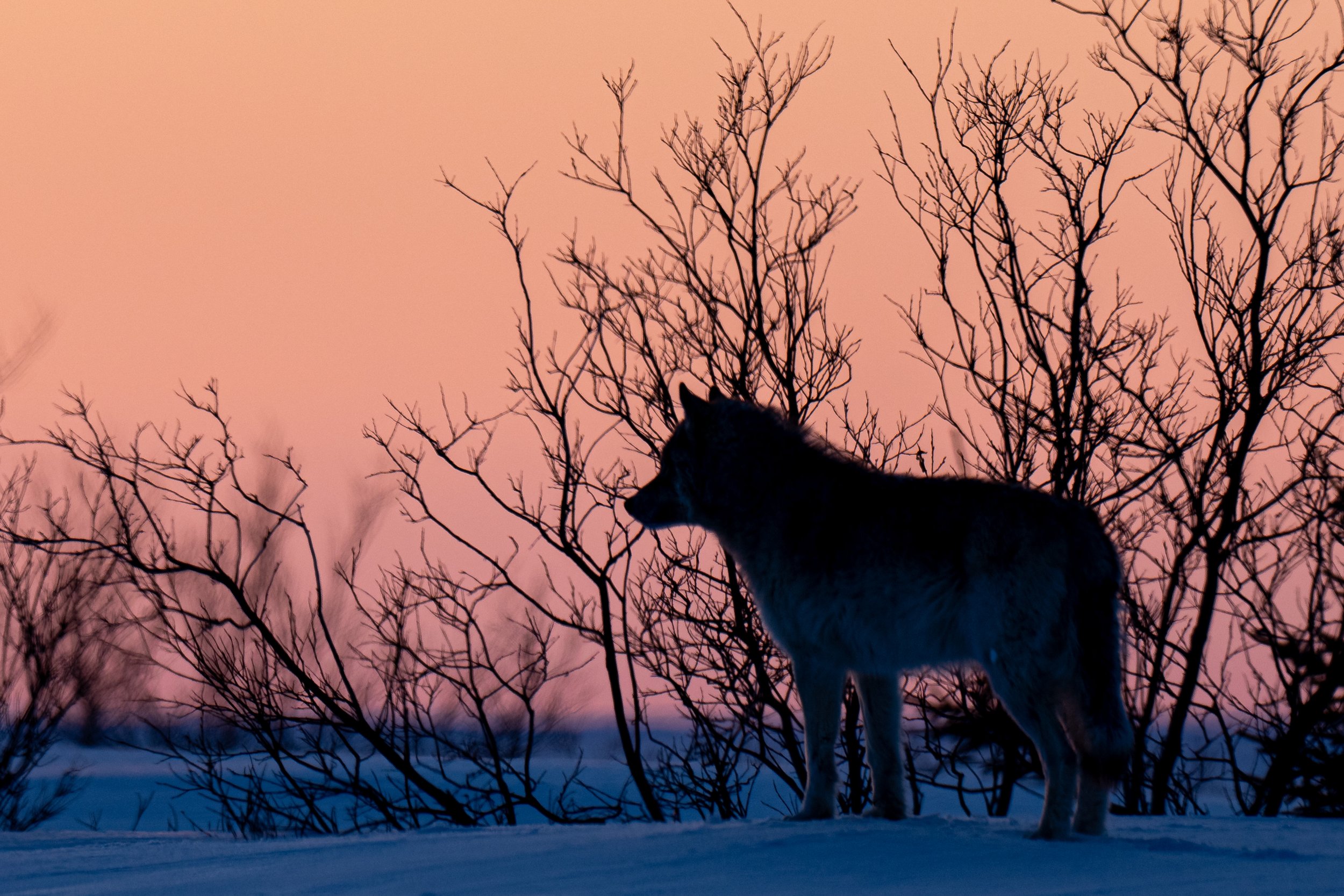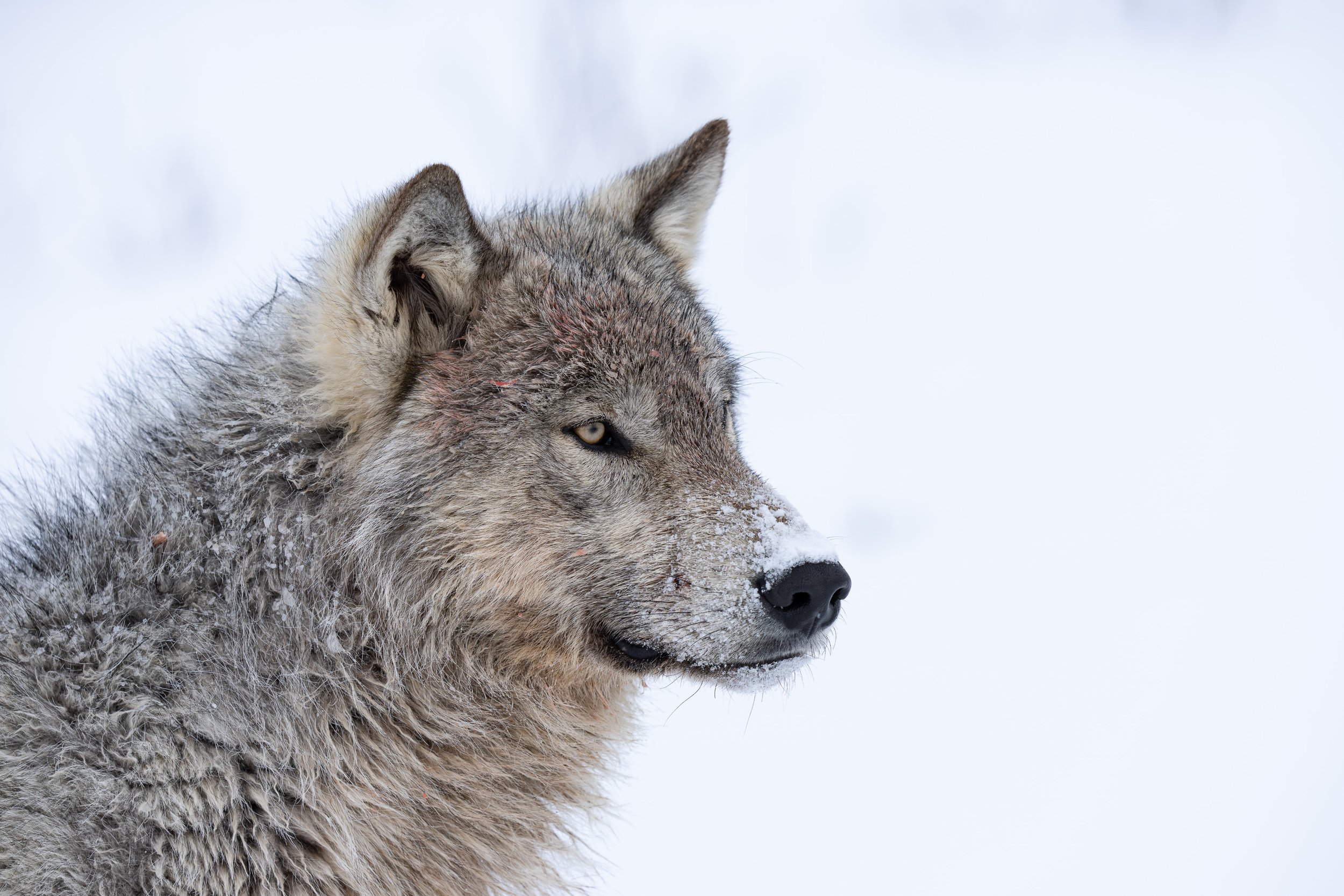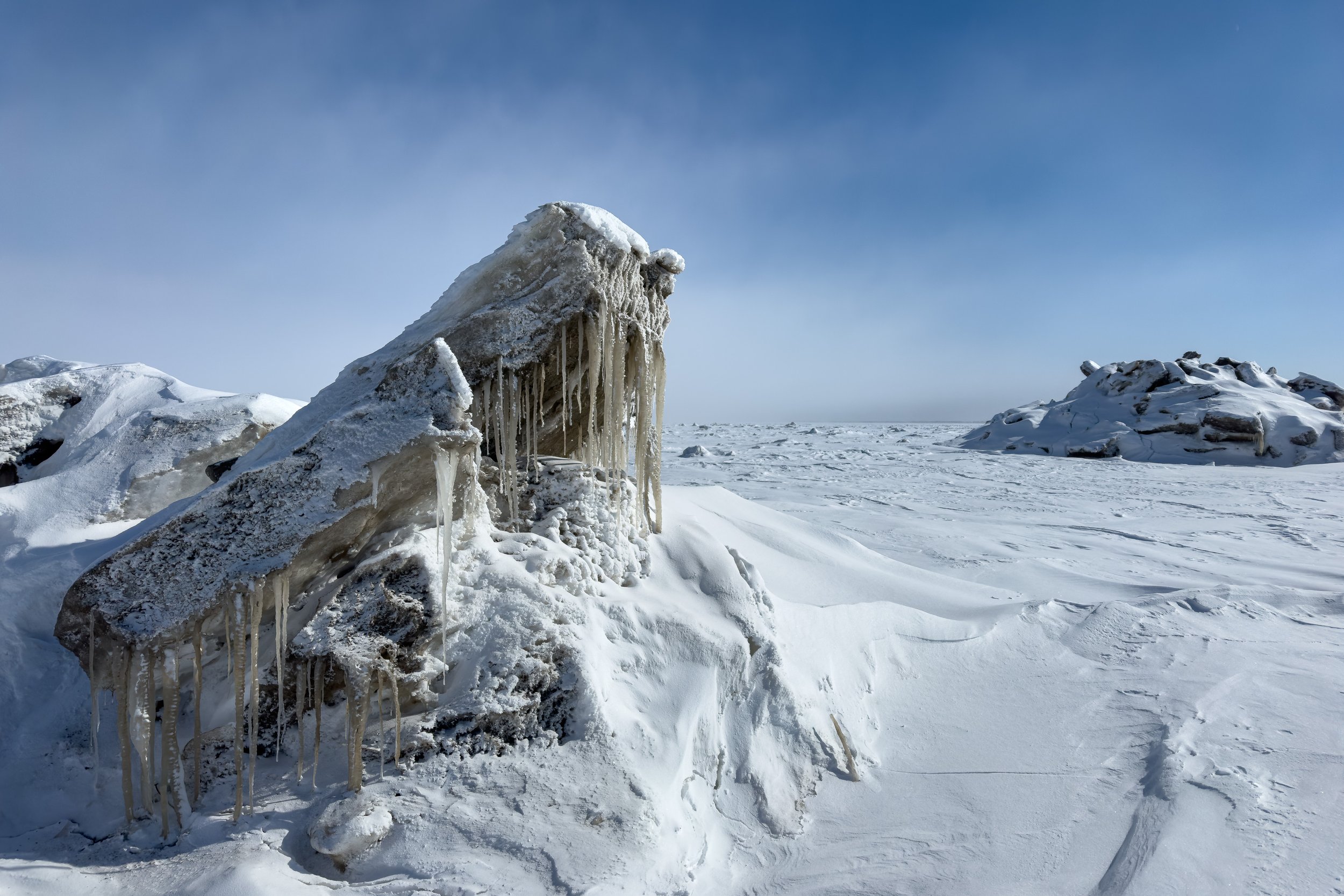Between Polar Bears and Wolves 2023
February usually is the coldest month at the coast of Hudson Bay. Temperatures can be as low as -40°C (-40°F), even without the windchill. And there is plenty of wind there, even ground blizzards with blue skies above. The rewards for enduring these conditions are big, though. The first three weeks of our stay, our quest was to find polar bear moms with their cubs heading from their denning area to the sea ice. The remainder of our trip was more focused on observing and studying the local pack of cloud wolves. While conditions were unusually cold, even for this area, this was by far our most successful and rewarding trip ever!
Winter Gear
Any trip to the North involves a lot more planning than trips to warmer destinations. This starts with bringing the right winter gear. We usually rent warm Quartz parkas and FXR snow pants from tour operator Churchill Wild. We just don't get that kind of winter gear at home in Europe. While you could also rent warm boots, we have bought our own Baffin Apex boots a few years ago. Having your own boots is just the little extra comfort you sometimes want.
Together with some merino and fleece layers, the risk of getting cold is slim. The biggest challenge in the cold is usually sweat management. With four or five layers of warm winter clothing, you will start sweating easily. Walking up a snow drift or digging out a snowmobile that's stuck gets you hot quickly. That's why dressing in layers is important. And that also explains, why we were sometimes collecting firewood with just our fleece jackets, at -40°C (-40°F).
Getting There
Getting from Switzerland to Nanuk Polar Bear Lodge involves four flights and at least three days. However, we decided to arrive a few days early in Winnipeg to have some flexibility. Luckily, we didn't need this extra time as our flights were (mostly) on time and our baggage arrived without any delay. That left us with some time to spend in Winnipeg and to get everything done that required a fast internet connection. The next month will be spent off the grid, with just some satellite internet.
From Winnipeg, we flew to Thompson with regional carrier CalmAir. While the name of this airline sounds pretty reassuring, C.A.L.M actually are the initials of the airline's founder. Nonetheless, our flight to Thompson was calm and comfortable. After changing from the small airport building to an even smaller private hangar, we were already en route for the coast. The flight from Thompson to Nanuk is a straight line along the Nelson and Hayes rivers, flying over York Factory and then along the coastline directly to the lodge. We arrived there on a sunny day with a temperature of -32°C (-26°F). Which would be one of the warmer days, which we soon learned…
The Quest, Part One
Polar bear moms are giving birth to their cubs in snow and peat dens in late December, usually dozens of kilometers inland. They are spending two to three months in and around their dens until the cubs are strong enough to start their challenging journey to the sea ice of Hudson Bay. This journey can easily take a few weeks, depending of the distance and the strength of the cubs. In the dense boreal forest, the polar bear families are usually safe. No predators venture that far inland. That quickly changes as they approach the coast. There, wolves are roaming the area. And while polar bears cubs are not their favorite prey, they would definitely take one down if given the opportunity. Mom has to safely navigate her cubs through this area. Polar bear moms know this. That's why they are taking their time to train their cubs before making the dash for the coast.
Photographing polar bear cubs in the wild is one of the biggest challenges of wildlife photography. This is especially true, when doing this the responsible way, meaning not harassing them around their dens but trying to locate them using a sophisticated search grid and then intersecting their projected path. That's the Churchill Wild way of doing this. And we love it. We had two scouts running their snowmobiles deep in the boreal forest, parallel to the coast. If they did not find any tracks there, this meant that no polar bears had crossed this line yet. If they did find tracks, they would run another parallel track closer to the coast. This method allows them to narrow down the position of a mom and cubs closer and closer. And then, they would use their inReach devices to instruct the guides and guests to where the polar bear family seems to be headed.
Fortunately, already on the first day of our trip, our scouts were successful. They found tracks about 35 kilometers (22 miles) inland, close to a river, about 25 kilometers away from the lodge. This was still off limits to us, since we were using snowmobiles and traditional Inuit sleds, so called komatiks. While a skilled snowmobile driver can get to amazingly inaccessible spots, even in the forest, that's not possible when pulling guests in a komatik. But still, already having found tracks was encouraging.
While our scouts were roaming the forest, we were exploring the coastline for the first few days. While it was sunny, temperatures were as low as -56°C (-70°F) with windchill. That was a new negative record, even for us! With temperatures slightly less cold, we were enjoying beautiful wildlife encounters. We watched wolves, snowy owls, ptarmigans and other local wildlife. We enjoyed having lunch outside despite the cold. We visited the old shipwreck of the Mooswa, a former Hudson's Bay Company boat. And we spent hours photographing the winter wonderland and some amazing sunsets. Life is beautiful!
Then, on day five of our trip, our scouts finally found the polar bear family to be moving towards the coast. We took a first attempt to see them. But they were still in an area inaccessible to us. But they were starting to move faster and were now just around 15 kilometers (10 miles) from the coast. Tomorrow would be our best chance. We therefore left the lodge already before sunrise. But just as we left the lodge, the wolf pack approached us and some wolves started howling. What should we do? Enjoy the chilling songs of the wolves at dawn? Or leave them for the slim chance of seeing a mom with her cubs? While not an easy decision, we were here for the mom and cubs, and therefore we sticked to our original plan and headed east. About 30 kilometers (19 miles) east of the lodge, we set up our emergency tent, fired up a small propane heater and started eating our breakfast wraps. But before we could even finish our breakfast, a new inReach message brought exciting news: mom and her two cubs are just 10 kilometers (6 miles) up a river, whose name we still can not pronounce (Nesayaketakayow River). We left our tent and one of the komatiks at our camp site and headed off. Getting to the "N river" was challenging, navigating a lot of deep snow. Upon reaching the river, we had to leave our remaining komatik behind, since the remainder of the approach would be "bush bashing", straight through the forest. Luckily, we were a small group and we could squeeze everyone on to the snowmobiles. Finally, we spotted the mom and her two cubs in a distance in an area of dense tamaracks. We quietly positioned ourselves so we could at least all catch a glimpse of them. Eventually, they started moving a bit and we could even get a better view. How tiny and cute the cubs were! We all had tears in our eyes when watching them. They were aware of our presence but not at all afraid. After hours of watching them, mom decided that it was now time to leave. She quickly got up and walked away, her cubs following her through the deep snow.
We were incredibly happy, and after waiting for a few more minutes, we slowly made our way back to where we left our second komatik. Big surprise, mom was just inspecting the wooden structure of this sled as we were approaching. She decided not to push her lucky and quickly headed off with her cubs. But still in plain view, she lay down and started rubbing her belly in the snow. The cubs quickly did the same. How incredibly cute!
We finally reclaimed our komatik and started to head back down the "N river" to collect our tent and other komatik. But mom and her cubs were using the river as their trail, too. Since we didn't want to push them, we just stayed put to allow them to move away. But one of the cubs had other plans. Us being the first human beings it had ever seen, caught its curiosity. It was approaching us, making hissing sounds. What exactly was the protocol, when a polar bear cub is approaching you...? Anyway, mom didn't like the idea and quickly got to her cub and brought it back to safety.
This was the last time, we have seen them. We made our way back to the lodge. After a short night, we headed east again before sunrise the next day. The weather turned bad for us with high winds and driving snow. But what was bad for us was good for the bears. Weather like this helps them to reach the sea ice without being intercepted by wolves. And luckily, they made it. We didn't see them anymore, but we saw three tracks, one big, two tiny, out onto the sea ice.
After today's early start, the long drive to the "N river" and back through a blizzard, we were pretty tired. But "our" wolves were back at the lodge. Therefore, we decided against a cozy lodge afternoon and headed out again with the snowmobiles. Since the entire wolf pack was using our snowmobile trail west, we had two options: We could either follow them in a safe distance, watching them from behind. Or we would try to speed with our snowmobiles through the deep snow parallel to our trail, leapfrog them in a distance and position ourselves on the trail to watch them approach us. Thanks to our guides, we managed to do the latter successfully. But not only once, but six times! Every time, the pack approached us, came close, checked us out and eventually wandered off. What an amazing day!
The remaining days went by quickly. We explored the rivers, photographed more wildlife and even enjoyed a wonderful bonfire out on the sea ice, watching the colorful sunset. Never have s'mores tasted better.
While the other guests had to leave after ten days, we were staying at Nanuk for the entire season. Therefore, our chances of seeing another polar bear family were still intact.
The Quest, Part Two
After having experienced so many wonderful wildlife encounters, we were sad to see our fellow guest leaving. But we quickly connected to the new group flying in. The first afternoon with a new group is usually spent doing a short "shakedown cruise". The idea is to get used to the cold, to the snowmobiles and komatiks, to handling the camera gear in the cold etc.
The next day, we headed east to the spot we set up camp ten days ago. Just before arriving back at the lodge, the guides radioed that the wolves were back at the lodge. Therefore, we sneaked into the compound of the lodge from the back. The wolves were all over the place, around the lodge, on the runway, even inside the fenced compound. And they were not afraid or aggressive at all. We could even watch them mating. That's a good sign and means that the Opoyastin pack will be having pups in approx. 64 days! One wolf approached us a bit more and we could see a mostly healed wound on her front leg. It was the same wolf we had seen last November. Knowing she was doing well really made our day.
We spent the next few days exploring the area. We spotted snowy owls and quite a few moose. But there was no sign of the wolves or of moms and cubs. On day five, this started to change quickly. In the afternoon, we took a trail into the boreal forest, south of the lodge. There, we spotted tracks that looked suspiciously familiar. Could it really be that a polar bear family was just 8 kilometers (5 miles) behind the lodge without anyone knowing it? Or were these just blown out wolverine tracks? Our scouts would try to find the answer tomorrow.
Just after a delicious dinner at the lodge, the northern lights made a wonderful appearance. And we heard the wolves howling, first one, then the entire pack. What an exciting day!
The next morning, we spotted the wolves in front of the lodge already before breakfast. We grabbed a quick bite and headed out onto the runway. The wolves were all around us. And then, history kind of repeated itself: our scouts sent an inReach message, that yesterday's tracks really were polar bear tracks. And they found a mom with two cubs in the forest, however in a pretty inaccessible spot. Again, we had to decide whether we would stick with the wolves or try to get to the polar bear family. And again, we quickly decided for the latter.
The approach was challenging, to say the least. We drove up yesterday's inland trail and then headed straight into the thick boreal forest with our snowmobiles. After crossing several small creeks and beaver dams, we finally made it to the spot. Mom was mostly sleeping while her two cubs were very active. What a cute sight. With the sun already low, we had to start making our way back to the lodge. After a long day, we fell asleep quickly, dreaming of polar bear cubs.
The next day, we headed out early, hoping to find "our" polar bear family again. And just as we arrived at the Mistikokan River, our scouts had located the bears again. Although still in the forest, we could slowly move into a spot where we had a wonderful view of them. We stayed there for the entire day, watching them sleeping, playing, sparring, nipping on mom's ears and even nursing. That was so incredibly cute and we were really sad to leave them shortly before sunset.
The next few days, we left the lodge before sunrise to have another chance to see the small family again. And we were so lucky! We could watch them for a total of five days. We could tell that they were growing stronger and more active every day. One day, they found a new favorite activity: climbing trees. Watching polar bear cubs climbing trees is pretty unreal and extremely cute at the same time. Moving up trees also brought new excitement to their play fighting. The cub at the bottom was constantly biting the other cubs butt...
Our last encounter with the bears was on the day our fellow guests had to leave. Together with a guide and just one other guest that was staying for another week, we took a final attempt to see them. And we quickly discovered them, just about 2 kilometers (1.5 miles) away from the coast. We soaked up every minute of this intimate encounter.
Then, in the afternoon, the next guests were taken straight to our observation point. They didn't have the comfort of having lunch at the lodge first, or unpacking, or having a "shakedown cruise". They just grabbed their camera gear and joined us for a wonderful afternoon with the bears.
The Wolves
The following trip was advertised as being focused on the wolves. But obviously, watching a polar bear family suited everyone more than well. What concerned us a bit, however, was the fact that there were indeed quite a lot of wolf tracks between the lodge and the location where we had last seen the mom with her cubs. We knew that wolves could kill a polar bear cub easily. Therefore, we hoped, that mom would lead her cubs to the safety of the sea ice in time.
The next morning confirmed our hopes. Despite there still being a lot of wolf tracks in the area, there were also our familiar three sets of tracks out onto the sea ice. They made it! Now, we could officially switch to "wolf mode".
After these wonderful, but also long and exhausting days, we enjoyed a more quiet pace, too. We spotted one wolf sleeping in the sun. That was nice, but we obviously hoped for more. And soon, we would get more, a lot more, actually.
The entire pack of ten or eleven wolves was back at the lodge. They played in front of the lodge and even checked out the fenced compound. Then, they eventually made their way out onto the frozen coastal flats. We followed them with our snowmobiles and komatiks and finally approached them a bit closer on foot. They were now all sleeping in the snow. Some of them had bloody faces and paws, which probably meant that they killed an animal not far away.
But for now, we just stayed put and watched them sleeping, probably just 50 meters (150 feet) away. Eventually, they got more active and started moving. One by one, they approached us, looking at us, sniffing at our gear, trying to figure out who or what we were. We had the entire pack surrounding us. While this might sound scary, it was extremely peaceful. They were ten wolves, we were eleven persons. Facing a pack of wolves alone would be dangerous and terrifying. But being in a group of people, kept everyone safe. Still, watching them from less than 5 meters (15 feet) away was just incredible!
Over the course of the next few days, we had more wonderful wolf encounters. Sometimes, they were on the move, sometimes they were just staying in one area. One evening, they were beautifully backlit by the sun during the golden hour. Memories like these will last forever.
For the last time, we had to say goodbye to a group of guests leaving, while a new group was flying in. Changeover days are always filled with mixed emotions. On one hand, after many shared memories, we were sorry to see one group leave. On the other hand, getting to know new people is always exciting, too.
During the last few days, we have set up trail cams in a few spots along the coast. One cam was put in a particularly interesting spot. We found a frozen river otter on Fourteens River. Poor guy was missing one leg, but otherwise looked fine (just frozen, and dead...). Therefore, we set up a trailcam there to maybe get some footage of who would chew on him. Unfortunately, that didn't work out. Whoever chewed up poor otter also chewed up our trailcam, including the memory card. Judging from the tracks, our wolf pack was our best suspect.
We decided to follow the tracks and not far away, we spotted the wolf pack moving in and out of a small tree line. With our binoculars, we could see that they were chewing on something, but we could not see what it was. They seemed pretty relaxed, however, walking up to us one by one before returning into the willows.
The next day, we could access the area. We found two moose carcasses, one adult moose and a calf. Since the kill site looked already several days old, this was probably where they had got their bloody faces a few days ago.
The following days were filled with more wolf encounters. It's hard to pinpoint one single best encounter. But one that ranks high on our list was just before sunset. The wolves were silhouetted against the golden sky and suddenly they all started howling!
Later, we spotted the pack again, further west of the lodge. Again, they were moving in and out of the willows. And a few raven were circling the area. This usually is a sign, that there is food close by. And it sure was. The pack was feeding on another dead moose. It's hard to tell, if it was a fresh kill or more like a food bank, an older kill they would revisit to chew some more (frozen) meet off the bones.
Northern lights are quite common in Northern Manitoba. We kept checking our aurora forecast app, which we knew were notoriously inaccurate. The running gag was, that if you want to know if the northern lights are dancing, don't check the forecast, but look outside. Makes sense. But we kept checking the forecast anyway. There is one main indicator for the likelihood of northern lights, the so called KP value. This indicator ranges from 0 to 9, with higher values meaning better chances or better lights. We had some of our most beautiful northern lights to date when the KP value was around 3 or 4. But for tonight, the forecast called for a KP of 7! And truly, these were the most amazing northern lights we had ever seen. They were green, purple, even bright red. And they didn't just dance on the northern horizon but across the entire sky, even south of us. We later learned that one of the strongest solar storms in more than ten years sparked this beautiful display.
Time to Say Goodbye
We have spent a month at Nanuk Polar Bear Lodge. And this has truly been our best trip ever. Not only did we see moms and cubs, but we could even spent five entire days watching the cubs develop new skills. The wolf encounters, too, were just incredible. Who gets to be surrounded by a pack of wolves, howling? We consider ourselves very privileged to haven been able to make this dream come true.
But there is more to a trip like this than wildlife. We have met new friends, and shared time with friends from previous trips. We would like to thank everyone of the Nanuk team and the Churchill Wild family for making adventures like these possible. Feeling at home from the first moment, knowing that the lodges are run responsibly to minimize the impact on the environment and having guides with an incredible knowledge about and respect for wildlife is just a perfect package. We will be back!


